The post The Art of Thinking Clearly: Beyond Labels, Concepts, and Boxes first appeared on Vinay Kulkarni.
]]>
Likewise, immerse yourself in the sacred study of the shastras. Let their wisdom fill your being. Let them challenge and shape your understanding. Let them expand your horizons. But do not become a Pandit. If others call you one, let them. But in your own mind, remain free. Become nothing. Just be.
Maybe you are a seeker. Maybe you are someone on a journey for knowledge, for truth. No—not even that. Seek to know, but do not let seeking become your identity. The moment you see yourself as “a seeker,” you have already built walls around yourself. The seeker’s journey becomes an institution, an establishment, a fixed path. And in doing so, you have lost the very thing you sought—truth in its rawest, purest, most unshaped form.
Whatever label you choose, that label will shape you. It will confine you. It will define the way you see the world. It will become your prison. You will become your position. You will become your point of view.
Certainly you can have a point of view. You must. But do not become identified with your point of view. Do not mistake your perspective for truth itself. When you attach yourself to a position, you become rigid. And an imprisoned mind cannot think freely. A free mind moves. It flows. It adapts. It shifts, not out of inconsistency, but out of a commitment to truth beyond personal investment.
Learn concepts. Study them deeply. Use them wisely. But do not become them. Concepts are tools, not truths. A map is not the territory. A model of reality is not reality itself. If you want to access phenomenal reality, you must be willing to break through concepts, not worship them. The greatest breakthroughs happen when we dare to step beyond what we know. The most profound realizations arise in moments of silence, when concepts fall away, and we see directly.
Write books, but do not become an author. Let words flow from you. Let them create, destroy, inspire, and challenge. But in your own mind, tell yourself you are nothing. The moment you say, “I am an author,” you risk writing for the identity rather than for the truth. Use the boat to reach the shore but then be ready to let that boat go after you reach the shore.
Most of all, never accept an ideology as your own. Never let yourself be absorbed into a belief system. The moment you do, you have decided the answer before truly understanding the problem. You have chosen a side before seeing the whole. You have limited your ability to think, to perceive, to understand. Ideology is a pre-packaged mental framework that spares you the effort of thinking for yourself. Do not take the easy way. Think. Question. Explore.
Do not paint yourself into boxes. Concept boxes. Position boxes. Point-of-view boxes. Category boxes. These are the barriers that restrict your mind. The moment you settle into a box, your vision is limited to its walls. You stop seeing beyond. You stop questioning what is outside. Painting yourself into concept or other boxes means you are superimposing a map or many maps onto reality and hence you will be only seeing a conceptual reality and the phenomenal reality underlying all concepts and ideas will be inaccessible to you. People say apples and oranges are different but they miss the fact that both are fruits. People say black and white are different but both are colors.
Learn to think without second hand labels and distinctions. Try to see things for what they are instead of looking at them through conceptual lenses. You know thinking is very risky business and one must be ready to encounter many strange beasts. But be a slayer of these beasts, never a victim. Learn to think “from” your “self.” The self is all there is.
Do whatever you need to do whenever you need to do it, but do not become identified with what you do. In any case, Sri Krishna has said you are not the doer. Most of the chaos and confusion in the world is because of people who have painted themselves into boxes coming to the table to debate—not to seek the truth, not to ask what is the truth of the matter and what is the right thing to do, but only to defend their right to superimpose their own maps onto the territory, only to defend their right to stay imprisoned in their own boxes and to persuade or cajole others to join them in those boxes.
As Sri Ramakrishna said, bondage is of the mind and freedom is also of the mind.
Freedom is always ‘from something.’ What are you to be free from? Obviously, you need to be free from the person you take yourself to be, for it is the idea you have of yourself that keeps you in bondage.
~ Sri Nisargadatta Maharaj
Step outside all these boxes and enter the nothing box. The Shoonya box. This is not an empty void. It is not a lack of thought. It is a state of pure, unfiltered awareness. A space within your mind that is directly connected to the cosmic mind. In this space, creativity flows unhindered. Insights arise without preconceptions. Understanding emerges from the depths, untainted by dogma, ideology, or identity.
Certainly, think out of the box. But let your mainstay be the Shoonya box. It is from this place of absolute emptiness that the greatest ideas, the deepest wisdom, and the most transformative breakthroughs arise. And the best part? It has been inside you all along.
So be. Just be.
The post The Art of Thinking Clearly: Beyond Labels, Concepts, and Boxes first appeared on Vinay Kulkarni.
]]>The post Collaboration for Truth first appeared on Vinay Kulkarni.
]]>Collaboration is not merely an option; it is an absolute necessity. There is no alternative. For truth, in its essence, is vast, infinite—like the radiance of a billion blazing suns. The most enlightened among us can only catch fleeting rays of this boundless light. And yet, when those who have grasped these luminous, elusive rays come together, weaving their fragments into a greater whole, something profound emerges. This is how the Vedas, the Upanishads, and the Shastras were born. Piece by piece, ray by ray, the scattered brilliance of truth was gathered, reassembled, and given new form.
The sun is thus reborn—not in its original form, but in a new way, blazing again with renewed intensity. It stretches far, penetrates deeply, and gives birth to fresh meaning, new understanding. It does not merely illuminate the present; it elevates entire societies, expands consciousness, and seeds future revelations. But even as this process unfolds, individuals continue to grasp only rays of the infinite. Many may capture the same ray, each planting and nurturing it within the fertile expanse of their inner being. These rays, in turn, become new suns, each shining in its own way, yet all originating from the same primordial source.
This is the nature of truth. It spreads in myriad forms, penetrates diverse minds, and resonates through countless voices. Its expression may sound distinct, even unique, but at its core, it arises from the same cosmic sun—the same universal womb. No mortal can stare directly at the original sun; its sheer brilliance would blind him. Even ecstasy, if too intense, overwhelms the nervous system, rendering it incapable of withstanding the full force of truth. Thus, in her infinite compassion, Mother Nature offers it in a diffused form—gentle, palatable, and accessible.
But there are those rare souls, like Abhinavagupta, who see beyond the veil. Perhaps the Divine Mother, in her affectionate way, pulled him by the ear for his audacity. Perhaps she smiled, forgivingly, for she recognized the greatness in him. He was not merely a seeker of truth—he was the great one, the seer, the knower. And he saw with unclouded eyes what few dared to perceive: all these fragmented truths, all these seemingly separate suns, are but the sons of the One Great Sun.
And so, it is. Truth shines through many sons. And unlike what some may believe, one need not be bound to a single path to reach the Source. Any son can lead the seeker to the Sun, for in the deepest reality, there are not many suns—there is only One. Beneath the surface of all diversity, at the foundation of all existence, lies the singular essence of unity.
Ekam Sat, Vipraha Bahuda Vadanti—Truth is one; the wise speak of it in many ways.
The Multiplicity of Truth
While individuals may capture different aspects of truth, these are but expressions of the same cosmic reality. As the ancient saying from the Rigveda states: *Ekam Sat, Vipraha Bahuda Vadanti*—Truth is one; the wise express it in many ways. This multiplicity does not indicate divergence but rather the vastness of truth’s essence. The sun, though one, manifests through countless rays, each illuminating a unique perspective.
No single individual can comprehend the full radiance of truth, for its brilliance is overwhelming. Nature, in her compassion, presents it in a diffused form—gentle and accessible. Yet, there are rare seers, like Abhinavagupta, who perceive the unity underlying all expressions of truth. These enlightened beings remind us that the many rays of wisdom stem from the same primordial source.
Pratibhigya Hrudayam
“In Pratibhigya Hrudayam, the foundational understanding is that there is a fundamental unity underlying all apparent differences in the universe. It suggests that there is a single, all-pervading consciousness (often referred to as “Chiti” or “Shiva”) that manifests in endless forms throughout the universe. Despite the multitude of diverse phenomena, experiences, and entities, they are all expressions of this underlying consciousness. The central idea is that the same essence is shared by everything, whether animate or inanimate” says Dr. Raj Nehru in his article, “Kashmir Shaivism and Quantum Mechanics: How Observation Shapes Reality.”
Swami Vivekananda on the Journey of Truth
Swami Vivekananda profoundly articulated that the various forms of worship and philosophical traditions are not errors but different stages in the journey from lower truth to higher truth. He emphasized that what we perceive as darkness is merely a lesser degree of light, and impurity is simply a lesser form of purity. By adopting this perspective, we cultivate an attitude of love and sympathy toward all paths of knowledge and devotion.
Vivekananda warns that truth is often far from comfortable. The quest for truth requires us to step beyond comfort zones, challenge our assumptions, and embrace realities that may initially seem unsettling.
The Nature of Knowledge and Its Limitations
Sri Aurobindo offers deep insights into the nature of knowledge and its limitations. He distinguishes between knowledge perceived through the mind and the higher knowledge attained through direct consciousness. The mind, by its nature, cannot fully grasp truth; it presents only partial, veiled glimpses. True knowledge, however, is self-existent within the being and is not subject to mental distortions.
Ignorance arises from limitation, error results from deviation, and falsehood is born from distortion. Knowledge, however, is not dependent on ignorance; it emerges independently from the depths of our existence. The process of seeking truth is, therefore, not about negating ignorance but about unveiling the innate knowledge that already resides within.
The Human Challenge in Bearing Truth
T. S. Eliot insightfully observed, “Humankind cannot bear very much reality.” The weight of absolute truth is immense, often beyond human capacity to fully assimilate. This is why truth is revealed progressively, allowing individuals to integrate its light without being overwhelmed.
As seekers, we must cultivate humility, recognizing that no single perspective can claim monopoly over truth. Instead, we should embrace collaboration—bringing together diverse insights, traditions, and experiences. This collective approach mirrors the process by which ancient wisdom was assembled, forming a great repository of knowledge.
Truth, in its infinite brilliance, cannot be confined to a single expression. It manifests in myriad ways, guiding seekers along diverse paths. While individuals may perceive only fragments, the collaborative effort of humanity allows for a more complete understanding.
The post Collaboration for Truth first appeared on Vinay Kulkarni.
]]>The post Cutting through the misty veil of Maya first appeared on Vinay Kulkarni.
]]>In the ancient text of Yoga Vasishtha, sage Vasishtha teaches: “The mind creates its own bondage and the mind creates its own liberation.” This profound truth lies at the heart of how assumptions shape our reality, creating suffering where none need exist.
The Upanishads speak of “avidya” – ignorance that clouds our perception of reality. As the Katha Upanishad states: “The self-existent Lord created the senses to turn outward. Thus we look to the world outside and see not the Self within us.” This outward gaze leads us to paint reality with the colors of our assumptions, missing the deeper truth that lies beneath.
Sri Ramakrishna taught through a simple parable: A man walking in darkness saw a rope and assumed it was a snake. His heart pounded, his body trembled with fear, until someone brought a light and showed him it was merely a rope. Such is the nature of our assumptions – they create phantoms that haunt us needlessly.
The Bhagavad Gita speaks of “gunasya dharma” – the inherent nature of things. When we assume, we override this natural state with our mental projections. As Krishna counsels Arjuna: “Perform action, O Dhananjaya, abandoning attachment, being steadfast in yoga, and balanced in success and failure.” This balance is impossible when we are caught in the web of our assumptions.
An ancient Indian tale powerfully illustrates this truth through a story captured in the beautiful Kannada poem “Keliddu Sullaaga Bahudu” (What you hear may be false, what you see may be false). The poem tells of Gangamma, who lived in a forest dwelling with her baby and a faithful mongoose. One day, needing water, she left her baby in the mongoose’s care. While she was gone, a cobra entered their home, threatening the child. The loyal mongoose fought and killed the snake, its mouth stained with blood from the battle. When Gangamma returned and saw the blood on the mongoose’s mouth, her mind immediately conjured the worst scenario. In her anguish and rage, she struck the mongoose dead with her water pot. Only then did she enter to find her baby safe, sleeping peacefully beside the dead cobra – a tragic testament to the price of hasty judgment.
This story reveals a profound truth about the physiology of assumption. When we make erroneous assumptions, particularly those that envision worst-case scenarios, our body and mind don’t distinguish between imagination and reality. They react as if our darkest fears are actually occurring, triggering a cascade of physical, physiological, mental, and emotional responses. Just as Gangamma’s assumption led her to commit an irreversible act, our assumptions can create self-fulfilling prophecies in three devastating ways:
(1) We make our worst fears manifest through our misguided reactions
(2) We amplify situations beyond their actual severity
(3) We inflict significant physical and emotional damage upon ourselves
To counter this phenomenon, we can adopt a practice that involves regulation of our breath – our most fundamental connection to life itself. The practice is focused on establishing and returning to what we might call our “base breath.”
To find this base breath, begin by surrendering – let the body breathe by itself, without any effort or control. Observe how the breath flows when you relinquish all attempt to guide it. This natural, effortless breathing is your base state. Like a village woman carrying a pot of water on her head must maintain perfect balance to prevent spillage, you must maintain awareness of this breath as you move through your day.
As you encounter various situations and interactions, notice how your breath responds. Does it quicken when someone doesn’t return your call? Does it become shallow when you feel slighted? These changes in breath pattern are early warning signs of assumption and reaction taking hold. The practice is simple yet demanding: whenever you notice your breath deviating from its base state, gently guide it back. Don’t fight or force – simply return to that natural rhythm you identified in moments of peace.
This practice of breath awareness gradually leads us toward the yogic ideal of “stitha prajna” – the state of steady wisdom where external events no longer provoke strong reactions. Just as a deep lake remains undisturbed by surface waves, one who maintains awareness of their base breath develops a profound stillness that prevents hasty assumptions from taking root.
The ancient wisdom traditions understood what modern science now confirms: our bodies respond to our thoughts as if they were reality. When we assume the worst, our nervous system activates its stress response – cortisol floods our system, our heart rate increases, our breathing becomes shallow, and our capacity for clear thinking diminishes. This biological reality makes the practice of breath awareness not just spiritually significant but physiologically essential. Modern medical science reveals the full scope of how anxiety and fear-based assumptions affect our bodies:
1. Central Nervous System: When we make fearful assumptions, our brain floods our system with stress hormones like adrenaline and cortisol. While these hormones are helpful for genuine threats, chronic activation through persistent negative assumptions can lead to headaches, dizziness, and depression.
2. Cardiovascular System: Fear-based assumptions trigger rapid heart rate, palpitations, and chest pain. Chronic anxiety can increase risk of high blood pressure and heart disease.
3. Respiratory System: Anxiety causes rapid, shallow breathing – exactly what the practice of base breath awareness helps prevent. This can worsen conditions like asthma and COPD.
4. Digestive and Immune Systems: Chronic stress from persistent negative assumptions can cause stomach aches, nausea, diarrhea, and weakened immunity, making us more vulnerable to illness.
5. Muscular System: The tension created by anxiety and fear-based assumptions can cause chronic muscle tension and physical fatigue.
By maintaining our base breath, we create a biological anchor that helps prevent our body-mind system from spiraling into these assumption-driven stress responses. This practice becomes both a spiritual and medical intervention.
As the Kannada poem concludes: “Nidhaanisi Yochisidaaga Nijavu Thilivudu” – When we think calmly and carefully, the truth becomes clear. This wisdom echoes through every tradition that teaches us to pause, breathe, and look more deeply before allowing assumptions to guide our actions.
The Mundaka Upanishad declares: “Truth alone triumphs, not falsehood.” Our assumptions are often falsehoods we tell ourselves, veiling the simple truth of what is. The practice of breath awareness becomes our tool for lifting this veil, allowing us to see reality as it truly is, moment by moment.
In this way, we transform what could be poison into medicine, learning from each instance where our assumptions led us astray. Every challenging interaction becomes an opportunity for growth, every misunderstanding a step toward wisdom.
A beloved tale* carries this wisdom forward: A king once asked his wise men, “Is there a single mantra that holds truth for all moments – in victory and defeat, in joy and sorrow?” After much deliberation, they presented him with a sealed message, with one condition – he could open it only in his darkest hour.
Months later, the kingdom fell to invaders. The king fled alone, eventually finding himself trapped at the edge of a cliff, enemy horses thundering closer. In this moment of despair, sunlight glinted off his ring, reminding him of the message. With trembling hands, he opened it and read: “This too shall pass.”
Something shifted within him as he absorbed these words. Just as his days of glory had passed, so too would this moment of danger. In his newfound calm, he noticed for the first time the stunning beauty of the cliffside – a part of his own kingdom he’d never truly seen before. The sounds of pursuit faded as his enemies took a different path through the mountains.
The king survived, regrouped his forces, and eventually reclaimed his kingdom. During the magnificent celebration that followed, as flowers rained down from every window and songs of victory filled the streets, he felt pride swelling in his chest. “Truly,” he thought, “I am invincible.”
But then the sun caught his ring again. Reading those same words – “This too shall pass” – his pride dissolved into wisdom. He realized: neither the defeat nor the victory belonged to him. He was simply witnessing the endless dance of life’s changing circumstances.
This story illuminates a profound truth: our assumptions about both triumphs and troubles are equally misleading. Nothing is permanent – not our judgments, not our fears, not even our certainties. When we truly understand this, we can release our grip on assumptions altogether and become pure witnesses to life’s flowing river.
In doing so, we honor both the ancient wisdom and our modern need for clear, compassionate understanding in an increasingly complex world. For in the end, all assumptions shall pass, but the truth of what is remains ever-present for those with eyes to see.
*https://www.citehr.com/346028-too-shall-pass-thought-provoking-story.html
The post Cutting through the misty veil of Maya first appeared on Vinay Kulkarni.
]]>The post Success in Being Who You Are first appeared on Vinay Kulkarni.
]]>
In the vast landscape of human experience, success is often defined by material achievements, societal recognition, and the pursuit of goals. This definition propels countless individuals into a relentless chase, believing that fulfillment lies somewhere beyond their current state. However, the timeless wisdom of the Vedas, Upanishads, Bhagavad Gita, Ashtavakra Gita, Avadhuta Gita, Kashmir Shaivism, Shiva Sutras, and other ancient scriptures offers a radically different perspective: success is not something to be achieved; it is an inherent state of being. This article delves into various definitions of success, distills insights from ancient teachings, and ultimately settles on a profound, effort-free definition of success rooted in the eternal bliss of the Self.
The Conventional Definitions of Success
From the earliest days of human civilization, success has often been tied to external accomplishments. Wealth, power, influence, and intellectual mastery are frequently viewed as hallmarks of a successful life. Modern thinkers like Steve Jobs emphasize passion, perseverance, and the ability to endure hardship:
“You’ve got to have an idea or a problem or a wrong that you want to right… Otherwise, you’re not going to have the perseverance to stick it through.”
This perspective highlights the value of determination and effort, presenting success as the result of a journey through challenges. Similarly, Paramahansa Yogananda equates success with sustained effort and alignment with divine will:
“Your success in life does not depend only upon natural ability; it also depends upon your determination to grasp the opportunity that is presented to you.”
While inspiring, such definitions imply that success lies in the future, creating a perpetual pursuit. This idea, though empowering, often leads to dissatisfaction, as the goalpost of success keeps shifting.
Key insight: By the time a person begins to think, a very tall and deep foundation of pre-digested, undigested, cooked, uncooked thought has already been built in his mind. So, when he or she beings to think, the thoughts arise from this foundation, this substratum. The key building blocks which are full of half-baked assumptions, unverified “facts” and untested “theories” are already there. These are never brought out and examined under the sun. These are never revisited. 99% of the people don’t even know these things exist in their minds. They truly, honestly believe their mind is generating pure and original thoughts independent of this layer foundation of old thought material. I encourage everyone to take an earth mover and dig up these mounds of thought earth and see what you find. So for most people the definition of success does not come from inside, it comes from outside mixed with all that other junky thoughts using which their mind was actually constructed! So, they may be able to define success but they may not be able to tell you why they want that so bad!
Effort and Fate: The Teachings of Sage Vasishta
Sage Vasishta’s teachings offer a nuanced view of effort and fate. He describes fate as the cumulative result of past actions but asserts that present effort has the power to transform it:
“Present acts destroy those of the past life, and those of the past life can destroy the effect of present acts, but the exertions of a man are undoubtedly successful.”
He compares the struggle between fate and effort to two rams locked in battle, where the stronger one prevails. This philosophy encourages human agency and acknowledges the transformative potential of courage and diligence. Yet, it also cautions against despair when external circumstances seem insurmountable:
“As a hail shower lays waste the cultivation of a whole year, so also does predominant fate sometimes overpower the attempts of this life. However, it does not behoove us to be sorry at the loss of our long-earned treasure, for what does it serve to have sorrow for something that is beyond our control?”
These teachings emphasize balance: effort is essential, but surrendering to the flow of life is equally important.
The Inner Alignment: Swabhava and Svadharma
In the Bhagavad Gita, success is framed as alignment with one’s Swabhava (inherent nature) and Svadharma (duty aligned with that nature). Krishna advises Arjuna:
“It is better to perform one’s own dharma, even imperfectly, than to perform another’s dharma perfectly.” (Bhagavad Gita 18.47)
This wisdom underscores authenticity. Success arises not from external validation but from living in harmony with one’s intrinsic qualities. For example, a teacher’s success lies in imparting knowledge, while a warrior’s success lies in upholding justice. Swami Vivekananda echoes this sentiment:
“Take up one idea. Make that one idea your life—think of it, dream of it, live on that idea.”
Such alignment leads to inner fulfilment, yet it still revolves around action and duty. Is there a higher state of success, free from even these subtle pursuits?

In the Bhagavad Gita (Chapter 18, Verse 14), Lord Krishna outlines five factors essential for the accomplishment of any action. These five factors emphasize the interplay between human effort, external circumstances, and divine grace:
The Five Factors of Success
1. Adhishthana (The Body):
The body serves as the physical foundation for performing actions. Without a functioning body, no action is possible, making it the first essential factor.
2. Karta (The Doer):
The individual who performs the action. The karta includes the soul’s identification with the body-mind-intellect complex, as influenced by the ego and willpower.
3. Karana (The Instruments):
These are the various senses, organs, and tools required to carry out the action. For example, hands for manual work, speech for communication, or external tools for achieving specific goals.
4. Cheshta (Effort):
The effort, energy, and intention put forth by the individual to accomplish the task. This includes physical, mental, and emotional exertion.
5. Daiva (Divine Providence):
The unseen forces, destiny, or grace of the Divine that influence the outcome of an action. While effort is crucial, divine will and external circumstances also play a significant role.
Even if you can control and manipulate the first four factors, the fifth factor is something you cannot control by definition!
The Bliss of Effortlessness: Insights from the Ashtavakra and Avadhuta Gitas
The Ashtavakra Gita takes us beyond action and duty, pointing to the ultimate realization that success is not a pursuit but an inherent state:
“You are the one witness of everything, and are always completely free. The cause of your bondage is that you see the witness as something other than this.” (Ashtavakra Gita 1.7)
This teaching shatters the illusion of becoming. It asserts that the Self is already complete, requiring no external achievements to validate its existence. The Avadhuta Gita expands on this:
“The Self is pure consciousness, beyond action, beyond desire, beyond effort. It is untouched by the fruits of actions and free from the illusions of gain and loss.”
Abhinavagupta, a luminary of Kashmir Shaivism, describes the experience of self-realization as a state of spontaneous bliss:
“The supreme reality is the universal consciousness. When the individual realizes their unity with this consciousness, they attain the state of effortless freedom, known as ‘Sahaja’ (natural state).”
The Shiva Sutras echo this sentiment:
“By meditation on one’s own true nature, the universe becomes an extension of the Self.” (Shiva Sutras 1.5)
In a sense, success lies in the effortless awareness of the Self, transcending the limitations of effort and duality. Because this success aligns with the cosmic purpose of your life!

The Pot of Water: A Metaphor for Inner Focus
Imagine a village woman walking 2 miles to fetch water in a mud pot. She balances the pot on her head and walks back home. Her full focus is on that pot, and she pays no attention to the distractions around her. Even if she stops to talk to someone, she does so while keeping her focus on the pot. The pot represents her highest state of being—a state of bliss, peace, and presence. It symbolizes the state of being fully connected to the divine, being in communion with the eternal now, and surrendering to the flow of life.
This metaphor teaches that true success lies in maintaining unwavering focus on your inner state of bliss, regardless of external stimuli. It’s about avoiding reactions to external distractions that might disturb your state of balance and peace, just as the woman avoids actions that might cause the pot to fall. At every possibility of a disturbance, ask yourself, “The pot of water or reacting to the taunts of the other village women, which one is more important?”
The Yoga Sutras of Patanjali highlight this focus:
“Yoga is the cessation of the fluctuations of the mind.” (Yoga Sutras 1.2)
When the mind is steady, success is not sought but revealed as the natural state of being.
Success as Surrender and Stillness
Bhagavan Ramana Maharshi and Sri Papaji emphasize the power of surrender. Maharshi describes the waking world as a dream, urging us to transcend its illusions:
“Just as the dream-world, being only a part of yourself and not different from you, ceases to interest you upon waking, so also the present world would cease to interest you if you awaken to your true Self.”
Sri Papaji reinforces this with radical simplicity:
“Don’t try to become anything, don’t go anywhere, don’t do anything, and don’t undo anything. Simply stay quiet. This is bliss, nothing else.”
The Shiva Samhita adds another layer to this understanding:
“The yogi who sees all beings in the Self and the Self in all beings, whose mind is steady and filled with inner light, is truly free.”
These teachings redirect the seeker from doing to being. Success, in this view, is not measured by accomplishments but by one’s ability to rest in the effortless awareness of the Self.
A Unified Definition of Success
True success transcends all definitions rooted in effort, fate, or achievement. It is the state of being fully present, undisturbed by the past or future, and anchored in the bliss of one’s true nature. This state is characterized by:
1. Effortless Being: Success is not something to strive for but to recognize within. Like the flute in Krishna’s hands or Shiva’s damaru, you are an instrument of divine harmony.
2. Inner Focus: Maintain unwavering awareness of your inner state, like the woman balancing the pot of water. Engage with the world without losing sight of your inherent bliss.
3. Surrender to the Divine: Let go of the illusion of control. Success lies in surrendering to the flow of life, trusting that you are already complete.
First come up with your Own definition of success without any input from anyone, living or Dead. no books, no videos, no movies, no speeches, no discourses, no coaching, no consultation; truly your own Definition of Success. One that does not give rise to a journey but keeps you rooted to where you are, in your highest state of effortless bliss. In other words, a definition of success that produces stillness rather than furtive movement. That helps you remain in an already experienced state of bliss and in fact helps you establish it or establish yourself in it more strongly. Something that does not take you anywhere – only makes you realise there is no where to go but right here, right now. Something that makes you realise that this shore is that shore and there is no ocean to cross. You are already in the ocean of joy. If your definition of success can show you how to remain in the ocean of bliss you have already discovered yourself to be, then its a keeper. No other person can show you how to be successful as only you know your own purpose. You should!
Practical Steps to Embody Success
To integrate this profound understanding into daily life, consider these practices:
1. Self-Inquiry: Reflect on the question, “Who am I?” This will reveal the false identifications that keep you bound to the pursuit of external success.
2. Mindful Awareness: Treat your inner state like the pot of water. Stay centered, avoiding reactions that disturb your equilibrium.
3. Detach from Outcomes: Follow the Bhagavad Gita’s principle of Nishkama Karma (desireless action). Act with sincerity but without attachment to results.
4. Seek Wisdom: Immerse yourself in the scriptures, such as the Shiva Sutras, Upanishads, and Gitas. Their teachings illuminate the path to effortless success.
5. Surrender Daily: Begin and end each day with a moment of surrender. Acknowledge that your true nature is beyond effort and achievement.
Success, as defined by the highest teachings, is not a destination or an achievement. It is the realization that you are already complete, already blissful, and already free. The pot on the woman’s head is your inner state of peace. Walk through life with grace, undisturbed by external distractions or internal doubts. The world’s definitions of success will fade into irrelevance as you awaken to the truth that you are the success you have always sought.
The post Success in Being Who You Are first appeared on Vinay Kulkarni.
]]>The post Happiness is Not the Dish: It’s the Main Ingredient! first appeared on Vinay Kulkarni.
]]>Happiness is not the dish itself; it’s the main ingredient. Think of it this way: if you are caught up in extreme sorrow and, in that state, you cook a meal for someone, you’re not just serving food. You’re serving a dish seasoned with traces of your sorrow. Now contrast this with the idea of cooking in a state of joy. The meal you prepare will carry your happiness, becoming a vessel of positivity and delight for others.
This is exactly what Sri Krishna meant when he said, “Yogastha Kuru Karmani”—“Establish yourself in yoga, and then act.” To establish yourself in yoga means to connect with the divine infinite, the boundless source from which all happiness flows. Imagine a laptop running on battery versus one directly connected to a power source. The former will eventually run out of charge, while the latter operates endlessly. That’s the difference between seeking fleeting happiness and living in a permanent state of joy.
Sri Ramana Maharshi explains this beautifully: “So long as an external object is required for happiness, incompleteness is felt. When it is felt that Atman alone is there, permanent happiness stays.” This profound insight reminds us that as long as we depend on something outside ourselves, we’ll always feel a sense of lack. True happiness arises from within, from the realization of our own eternal, unchanging nature.
All this has been discussed ad infinitum over the centuries. That is not the point. The main point I am emphasising here, or you can say the chief trick or the key hack is the constant moment to moment monitoring of the state of your mind and emotions – like a concerned friend traveling with a sick friend, monitors and keep tracks of his condition. He continuously keep checking if all is well. Like the night watchman who keeps (used to the case) shouting, “Jagte Raho!” That is what this is! Be your own best friend and keep a friendly eye on your friend. Make sure he is not lapsing into reverie, anxiety, worry or regret. Even if they show up, one has to ask, “Is it happening right now? This very moment?” – And immediately your mind will realise it is hallucinating – either about the past or about the future. Then, ask, “How am I feeling right now, this very moment?”
Take a Deep Breath In…
One great discovery is the connection between thoughts, feelings and breath. By regulating the breath you can regulate the other two.Bhagavad Gita: Chapter 6, Verse 12-13
तत्रैकाग्रं मन: कृत्वा यतचित्तेन्द्रियक्रिय: |
उपविश्यासने युञ्ज्याद्योगमात्मविशुद्धये || 12||
समं कायशिरोग्रीवं धारयन्नचलं स्थिर: |
सम्प्रेक्ष्य नासिकाग्रं स्वं दिशश्चानवलोकयन् || 13||
tatraikāgraṁ manaḥ kṛitvā yata-chittendriya-kriyaḥ
upaviśhyāsane yuñjyād yogam ātma-viśhuddhaye
samaṁ kāya-śhiro-grīvaṁ dhārayann achalaṁ sthiraḥ
samprekṣhya nāsikāgraṁ svaṁ diśhaśh chānavalokayan
BG 6.12-13: Seated firmly on it, the yogi should strive to purify the mind by focusing it in meditation with one pointed concentration, controlling all thoughts and activities. He must hold the body, neck, and head firmly in a straight line, and gaze at the tip of the nose, without allowing the eyes to wander.
If you just do this, you will find that your incoming breath will become equal in duration to the outgoing breath. After sometime you will achieve a certain rhythm and with some practice you will be able to stay in that rhythm and ride that rhythm.
Bhagwan Nityananda explains how to breathe in the “Chidakasha Gita” (originally written in Kannada by Tulasi Amma, a disciple of Bhagwan):
“Just as we draw water from a well, we should draw breath; when we breathe out, it should be like letting down the bucket into the well. When we breathe out, it is the carbon (the impurities of the body); when we breathe in, it is the breath of Omkar. Breath of Omkar is the manas (mind).”
“The up going breath is like the wheels inside a clock. Its movement is inside; when the movement of the breath is internal, one will see the world in himself.”
Ramana has also spoken about breath.Sri Bhagavan said: “Control of breath may be internal or external.”
The antah pranayama (the internal breath-regulation) is as follows:
Naham chinta (I-am-not-the-body idea) is rechaka (exhalation).
Koham (who am I?) is puraka (inhalation).
Soham (I am He) is kumbhaka (retention of breath).
Doing thus, the breath becomes automatically controlled.
The practice of breathing out (rechaka) serves to purge the body of impurities. By leaving the nostrils untouched, the vital energy is suppressed altogether. The practice of breathing in (puraka) tends to fill the insides like clouds fill the sky. Then when breathing is stopped, its vibrations are also stopped. With the practice of holding of the breath (kumbhaka), the vital air is shut up in a closed vessel and this serves to stop the course of breathing.
Breathing is the operation of life and its suppression is the path to its extinction or nirvana. The vibration of breath is the action of the mind that produces the error of the existence of the world. The breath and mind being brought under control dispels this error.
The breath is the thread that connects you to the present moment. The breath is the switch. Press that switch and come back to the present moment. Just become aware of your own breathing. Go about life with while being aware of your breathing. Aware of your breath!
The Elusive Moment
The biggest barrier to happiness is our inability to live in the present moment. But here’s the catch: before you can live in the moment, you have to “recognize” it. To recognize it, you must “be” in it. And to be in it, your mind needs to stop wandering in all directions.
Arjuna, in the Bhagavad Gita, aptly describes the mind as “restless like the wind.” How, then, do we anchor it in one place? Ah, the eternal question! We’ve all wrestled with this elusive restlessness. Our thoughts race—past regrets, future anxieties, and a never-ending stream of “what ifs” and “if onlys.”
I’ve found that the only solution is a strict, almost militant decision to enjoy every single moment. This requires constant self-monitoring, a gentle check-in with yourself to ask: “Am I enjoying this right now?”
Take the simplest example: walking from your house to your car. Are you grumbling about being late, or are you noticing the crispness of the air, the rustle of leaves, or the warmth of the sun? What about your morning coffee? Sometimes, the coffee is just bad. And yet, we’ll dutifully finish it, thinking, “I started it, so I might as well finish.” But why? Why not pause, recognize that you don’t enjoy it, and get a cup you truly like?
Nisargadatta Maharaj speaks to this dependency on externalities: “You imagine that without cause there can be no happiness. To me, dependence on anything for happiness is utter misery. Pleasure and pain have causes, while my state is my own, totally uncaused, independent, unassailable.” What would life look like if your happiness was utterly independent of circumstances?
The same principle applies to larger moments. If you’re at a restaurant and the first dish served is terrible, you don’t have to endure an entire meal of disappointment. You can leave and find a place where you’ll actually enjoy the food. If you’re caught in a pointless argument, become aware of what’s happening and step back. Meetings spiraling in the wrong direction? Try to steer them or excuse yourself.
This isn’t about being selfish; it’s about treating every moment as precious—because it is. Why squander “in-between-happy-events” moments while waiting for some grand thing to happen? That great thing might happen. It might not. But what’s guaranteed is that this moment, right now, will never come back.
The Present Is All There Is
John Lennon once said, “Life is what happens when you’re busy making other plans.” And Buddha echoed this sentiment: “Do not dwell in the past, do not dream of the future. Concentrate the mind on the present moment.”
The truth is, life is a series of present moments. Yet, most of us are so consumed by regrets and anxieties that we fail to live in any of them. Think about it: when you wake up late, your first thought is often, “Why did I hit the snooze button?”—regret. Your second thought might be, “Now I’ll be late, and my boss will be angry!”—anxiety. In just two thoughts, you’ve ruined the first half of your day.
The philosopher Arthur Schopenhauer puts it bluntly: “We are always living in expectation of better things, while at the same time we often repent and long to have the past back again… Hence most people, if they glance back when they come to the end of life, will find that all along they have been living ad interim.” How tragic is it to realize, too late, that the life we dismissed as ordinary was the very thing we were yearning for?
Eckhart Tolle reminds us that the past is nothing more than a collection of former present moments, and the future is just a string of moments waiting to arrive. The only reality is now. By resisting this truth, by clinging to what we can’t change or fretting over what hasn’t yet come, we create pain. It’s like holding your breath—you’re only hurting yourself.
Resistance vs. Acceptance
The root of much of our pain is resistance—resistance to what is, to what we can’t change. Tolle puts it beautifully: “You can always cope with the present moment, but you cannot cope with something that is only a mind projection—you cannot cope with the future.”
The antidote? Observation and acceptance. Constantly ask yourself, “What will my next thought be?” This simple act can delay the onslaught of negativity, giving you a chance to breathe. And when those nagging thoughts come—the “should haves” and “could haves”—don’t fight them. Acknowledge them, let them pass, and move on. As Thich Nhat Hanh says, “If you abandon the present moment, you cannot live the moments of your daily life deeply.”
The Long Road to Discipline
Of course, none of this happens overnight. As M. Scott Peck writes in “The Road Less Traveled,” “Life is difficult.” But it’s precisely this difficulty that shapes us. The metaphorical road less traveled is filled with potholes, detours, and dead ends. Yet, by choosing it, we grow in ways we never imagined.
Grace and the Power of Silence
The Bhagavad Gita introduces the concept of grace as a divine force that sustains us through life’s challenges. Peck refers to it as a protective energy, a subtle instinct that helps us cope with trauma and hardship. When we align ourselves with this grace—through yoga, meditation, or simply mindfulness—we tap into an infinite source of strength and serenity.
And here is where silence becomes a gateway to that grace. As Paramahansa Yogananda reminds us in “Autobiography of a Yogi”, “The silence habitual to Sri Yukteswar was caused by his deep perceptions of the Infinite… In shallow men the fish of little thoughts cause much commotion. In oceanic minds the whales of inspiration make hardly a ruffle.”
Silence is not emptiness; it is fullness. It is the space where true inspiration arises, free from the noise of trivial thoughts. When we practice silence, we can connect to the depths of our inner being, where happiness flows effortlessly.
The Power of Small Decisions
Ultimately, happiness isn’t about grand gestures or life-altering events. It’s about the small, seemingly inconsequential choices we make every day. Choosing to savor your coffee. Choosing to step out of a negative meeting. Choosing to live fully in the now.
As Thich Nhat Hanh reminds us, “We have more possibilities available in each moment than we realize.” It’s up to us to recognize them, to seize them, and to let happiness flow through us, not as a result of our actions but as their foundation.
The final word
Happiness is here and now. It’s not waiting for you at the end of a long journey; it’s the road itself. Don’t squander your moments waiting for some grand event to validate your existence. Even moksha—liberation—is found in the present.
As we practice living in this state, we may stumble, but that’s okay. Awareness is the first step, and practice makes progress. So, how will you choose to live your next moment? Share your journey—I’d love to learn from you.
The post Happiness is Not the Dish: It’s the Main Ingredient! first appeared on Vinay Kulkarni.
]]>The post Riding the (bi)Cycle of Life! first appeared on Vinay Kulkarni.
]]>As T.S. Eliot wrote in Four Quartets, “We shall not cease from exploration, and the end of all our exploring will be to arrive where we started and know the place for the first time.” This reflects the essence of cycles—returning to familiar places with newfound wisdom, ready to face the journey anew.
Life, as observed in nature, spirituality, and human existence, revolves around cycles. And, if you recall from memory, you will find that this is generally true and has you’re your experienced also.
From the grand movements of celestial bodies to the minute rhythms of our own bodies, the cyclical nature of existence reflects an inherent balance, continuity, and opportunity for growth. Recognizing and aligning ourselves with these patterns is a step toward greater harmony, resilience, and understanding. Yet, there is something deeper and mystical about cycles – we will continue to explore and investigate over the coming weeks and months.
The Universality of Cycles
Continuing these observations about cycles in all aspects of life, we encounter some more: The circadian rhythms of our bodies synchronize with the rising and setting sun. The moon waxes and wanes, influencing tides and marking time. Seasons rotate, each with its own character and purpose, reminding us of nature’s rhythm. Even human emotions, relationships, and achievements follow the ebb and flow of success, failure, realization, and renewal.
In Sanatan philosophy, the concept of cycles takes a cosmic perspective through the Yugas—vast epochs representing the evolution and devolution of dharma (righteousness). This cyclical understanding underscores the belief that life progresses through repetition and renewal, allowing both individuals and societies to refine themselves over time. And this refinement is the real point of it all. Continuous growth and evolution.
Learning Through Cycles
Again, the cyclical nature of existence is not merely repetition but a profound opportunity for growth. Each turn of the cycle gives us a chance to:
• Learn from our mistakes: Mistakes are not endpoints; they are lessons. As cycles repeat, we are presented with similar circumstances, urging us to apply past learnings in a new way.
• Evolve spiritually: The process of reincarnation (punarjanma), as described in Hinduism, illustrates this beautifully. Each life is a new chapter in the soul’s journey, offering a fresh canvas to overcome karmic patterns and strive for liberation.
• Experience renewal: Like spring follows winter, cycles assure us that no matter how bleak a situation may seem, renewal and growth are inevitable. The sun will rise again and the flowers will bloom again. Good times will certainly return!
According to Vedanta, cycles are intrinsic to both nature and human progress. The Puranas describe how dharma declines and is restored in cycles, symbolizing the ongoing battle between forces of harmony (devas) and discord (asuras). These cycles culminate in moments of divine intervention—something significant happens to restore balance. And balance is the key to progress.
Sri Aurobindo captures this eloquently, explaining how progress is not linear but cyclical, marked by alternating phases of regression and growth. These movements, though seemingly repetitive, ensure forward evolution over time, much like planets orbiting their sun while advancing through space.
Finding Meaning in the Cycles
Recognizing life’s cyclical nature offers profound clarity. It teaches us:
• To accept change as inevitable and empowering.
• To find patience in stagnation, trusting that it precedes transformation.
• To embrace renewal with the understanding that every end is a beginning.
Riding the (Bi) Cycle: Skills for Harmony
Successfully navigating life’s cycles requires us to embrace the art of balance and resilience. Here are key principles to ride the cycle of life:
1. Confidence in the cycle: Trust that life’s rhythms will support you. Every winter ends, every night gives way to dawn.
2. Balance and adaptability: Just as a cyclist adjusts their pace and stance, we must adapt to the highs and lows of life. Pedal harder during challenging times; slow down and rest when needed.
3. Faith in recovery: Falling is not failure. The ability to rise, dust ourselves off, and continue is the hallmark of growth.
4. Awareness of others: In life’s interconnected web, our actions influence others. Avoid collisions—be mindful of others’ journeys while respecting your own.
5. Maintenance and self-care: Like oiling a cycle, maintaining balance in life involves regular self-care. Following a daily routine (Dinacharya) that aligns with nature’s rhythms keeps the body, mind, and soul in harmony.
6. Individuality of cycles: Every person’s journey is unique. Celebrate your own path without comparing it to others.
7. Energy management: Alternate between bursts of energy and rest. Life’s seasons require both intense action and quiet assimilation.
Life’s cyclical nature is not a constraint but a gift—a rhythm that encourages growth, resilience, and a deeper connection to the cosmos. By embracing the cycles of life, from the smallest daily routines to the vast epochs of cosmic time, we align ourselves with the natural order. With confidence, balance, and trust, we can thrive in this eternal dance, finding meaning and joy in every turn of the wheel.
Happy cycling!



The post Riding the (bi)Cycle of Life! first appeared on Vinay Kulkarni.
]]>The post Reclaiming Our Cities From the Edge of Chaos first appeared on Vinay Kulkarni.
]]>Cities are living, breathing organisms. They pulse with life through their green spaces, flow through their water bodies, and hum with the stories of their people. Yet, over decades of rapid urbanization, this harmony has been lost. Greenery has given way to concrete, air has turned heavy with pollution, and the cultural soul of our cities has been diluted.
But this is not irreversible. Cities can be reclaimed—not just as places to live, but as spaces that inspire, nurture, and connect us to nature and each other. To achieve this, we need a Dharmic approach—one that emphasizes balance, respect for natural and cultural systems, and the collective responsibility of all citizens.
This article presents a roadmap to transform cities into vibrant ecosystems where nature, culture, and humanity thrive together.
1. Policies That Set the Foundation for Harmony
Urban transformation begins with bold policies rooted in sustainability, equity, and long-term thinking.
Green Spaces are mandatory – cannot be optional!
Green spaces are not luxuries—they are essential lifelines for any city. Policies must mandate that a significant portion of urban land is reserved for parks, forests, and gardens. These spaces should be accessible to all, improving air quality, promoting physical and mental well-being, and fostering a sense of community.
We need beautiful water bodies in addition to green spaces!
Neglected lakes, ponds, and wetlands must be revived—not just as functional water reserves but as vibrant ecological and social hubs. These water bodies cool cities, support biodiversity, and provide spaces for reflection and recreation.
Tree Planting Should be Done Strategically and Scientifically
Planting trees isn’t just about numbers; it’s about understanding. Indigenous species like Peepal, Banyan, Amla, and Ashoka are not only culturally significant but also critical for improving air quality and supporting local ecosystems.
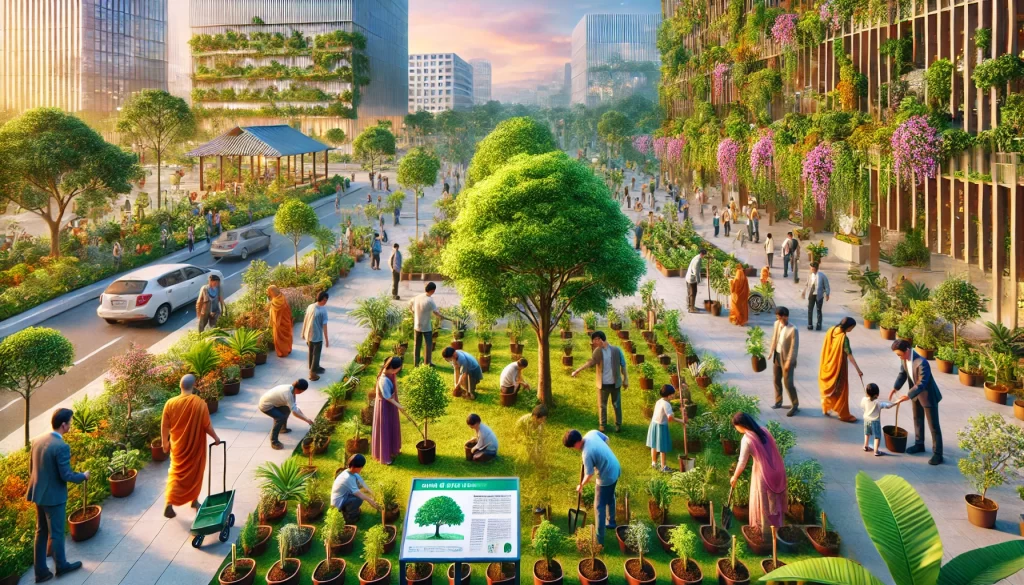
Quiet Zones and No-Vehicle Days

Noise pollution disrupts not only our mental well-being but also the delicate balance of urban ecology. Designate quiet zones where noise is strictly regulated. Introduce no-vehicle hours every week and vehicle-free days every month to reclaim peace and reduce emissions.
Temples are energy vortexes (not just places of prayer and worship) that are vital for metal health of citizens
In the Indian tradition, temples are more than places of worship—they are centers of positive energy. Strategically locating temples near green spaces and water bodies can amplify their impact, creating sanctuaries for spiritual renewal and community gathering.
Stop looking at Sanatani temples as religious structures. These are energy vortexes that enhance the positive energy in and around where they are located. These should be strategically built all over the city adjacent to green areas and water bodies.
Design Should Blend Aesthetics with Functionality
Indian aesthetics emphasize harmony and meaning. Public spaces and buildings should reflect this ethos. Murals, carvings, and thoughtful architectural designs can tell a city’s stories while serving practical purposes. This is how we weave beauty into the fabric of everyday life.
2. Builders Should be Seen as Custodians of the Future – but they need education.
Builders and developers shape the physical identity of our cities. They must see themselves as custodians of harmony, responsible for designing spaces that honor nature, culture, and inclusivity.
Eco-Friendly Design Principles – through education, policy and inspiration
Incorporate green roofs, vertical gardens, natural ventilation, and sustainable materials into all urban developments. These aren’t just trends; they are necessities.
Water Conservation Should be incorporated in Every Project
Rainwater harvesting, greywater recycling, and artificial wetlands should be standard features in every building plan. These systems are critical for cities grappling with water scarcity and urban flooding.
How can we Design for Everyone
- Provide public exercise areas, walking areas and cycling areas spread all over the city based on a certain density ratio that helps to cover th max number of people.
- Have certain walking only and walking + bicycling only areas throughout the city.
- Install meditation pyramids in all the green spaces and near water bodies. People should be Able to use these pyramids for a small fee to meditate and recharge anytime anywhere.
- Make these green spaces digital detox zones during 3 specific periods throughout the day. Let these times be the busiest times of the day.
- Make it possible to carry bicycles on metros and buses.
- Develop and implement a scientific tree planting strategy – particularly Peepal, Belpatra, Bad, Amla, and Ashoka trees.
- Incorporate: total quiet hours (1 hour of total silence) once a week and one day of total silence (8 hrs) once a month.
- Have at least 1 hr of zero vehicular traffic period per week and 1 day of no vehicles on the street per month.
- Every 3 months, every city would completely shut down (except for emergency services) for 24 hrs.
- Every locality should have a local cleanliness, culture and environment group or committee – organise clean your streets campaigns once a month.
- Include small but impactful libraries inside the temples and green spaces. Every city should have a library and bookstore on the wheels. Both types of libraries would contain curated books that help people understand the history of their towns and cities in various languages. Include a language and cultural enrichment centers at green areas, temples and libraries to help non-locals and immigrants learn local languages, culture and get guidance in terms of the cultural map of each town and city. Include murals, paintings, posters, pictures etc that tell beautiful stories of the history, culture and traditions of our towns, cities and states to keep them high up in public consciousness
- Offer a one day free open top bus tour of the city once a month.
- Measure and publish certain types of data about each area of the city and work with the local councils to manage those numbers: Air pollution, water pollution, sound pollution, cellular radiation etc. Build a suitable number of herb gardens/ medicinal forests for each city. Do some research to identify: how many trees of each type (and how many types are key and critical for the health of the city) should be available and in what density in each city to ensure a certain air quality level. I will come back with more such ideas in the next article.

Architecture must reflect inclusivity by addressing the needs of:
• The Elderly: Accessible walkways, benches, and safe public spaces.
• Differently Abled Individuals: Barrier-free access, tactile pathways, and clear signage.
• Children: Safe play zones and creative learning environments.
• Women: Well-lit public spaces, clean toilets, and access to safe drinking water.
Gardens in Every Home
Every home can contribute to the city’s greenery. A balcony garden, a rooftop patch, or even a small planter box can collectively add up to a significant impact.
3. Education for Builders and Architects
Builders and architects must go beyond functional design to create spaces that reflect respect for nature and culture.
Training in Dharmic Architecture
Introduce builders to the principles of vastu shastra and other traditional Indian architectural practices that align structures with natural energy flows.
Workshops on Sustainable Practices
Regular workshops can equip builders with practical knowledge about eco-friendly materials, energy-efficient designs, and waste reduction strategies.
Creativity Through Contemplation
Encourage architects to engage in practices like meditation and reflection. Deep contemplation often leads to inspired designs that resonate with both people and the environment.
4. Establishing a Wise City Council
Urban governance must move beyond bureaucratic efficiency to reflect wisdom, integrity, and a deep connection with the city’s needs.
- Create a “Wise City Council” made up of educated, informed, rooted, connected long term residents of the city who have history in the place and care about what happens to the city. (Also, just like we have Home Owner’s Associations, there should be some city association separate from the Municipality that has a significant say in everything to do with the city. It should have a culture committee and many other such committees for planned growth while retaining the city characteristics and history/culture etc.) This should include architects who are knowledgeable in Indian architecture, ecofriendly architecture, eco friendly materials and also have first hand experience and knowledge of how nature works.
- Dharmic architecture and dharmic design would ensure harmony between human structures and activity and natural cycles and processes. This is very important. To achieve one would need deep sadhana. Without such a deep understanding architects will do copycat designs or designs that create friction and conflict between man and nature.
- Some other key ideas: Spread gardens, green lung spaces and water bodies throughout the city ensuring all the citizens have easy access to greenery and water. Revive dead or neglected lakes and ponds. Let every house have a small garden however small.
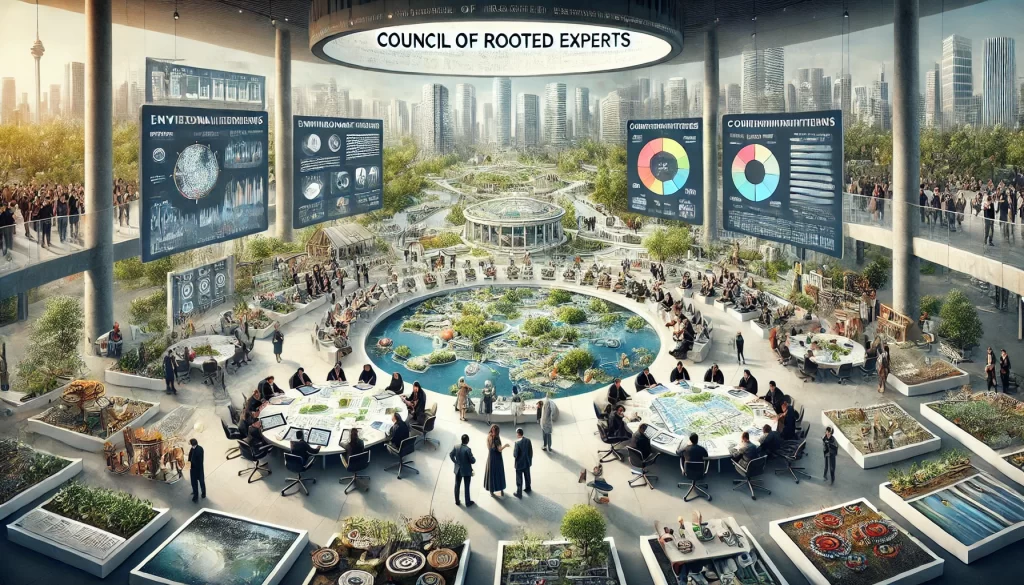
A Council of Rooted Experts
The council should include long-term residents, environmental scientists, urban planners, and architects with a strong understanding of the city’s cultural and ecological fabric.
Cultural Committees
Form subcommittees to preserve local traditions, languages, and arts. These committees ensure that modernization does not erase a city’s cultural identity.
Public Dashboards for Accountability – corporations, institutions, other commercial entities, universities, hospitals etc.
Introduce a public dashboard that tracks:
• Contributions to pollution and ecological degradation.
• Efforts to improve the city’s environment, culture, and livability.
Display this data at key locations such as airports, train stations, and public squares. Transparency fosters accountability and citizen engagement.
Corporate Town Halls
Empower the citizens’ councils to summon corporate leaders to town halls. These sessions would require them to explain their contributions to:
• Environmental sustainability.
• Cultural preservation.
• Community welfare and inclusivity.
5. Engaging Communities for Collective Action
The heart of any city lies in its people. Transformation is impossible without their active participation.
Quarterly “Let Us Make Our City Better” Challenges
Host contests in schools, colleges, and corporate offices to encourage innovative solutions for urban problems. These ideas can then be presented to local leaders, policymakers, and even the PMO, fostering a movement of citizen-driven change.
Monthly Cleanliness Drives
Organize neighborhood campaigns to clean streets, plant trees, and beautify public spaces. These initiatives build a sense of pride and ownership among residents.
Libraries and Cultural Centers
Set up libraries in parks, temples, and community hubs to preserve and promote local heritage. Mobile libraries can ensure accessibility to knowledge in underserved areas.
6. Transparency, Accountability, and Predictive Planning
Cities need tools that evaluate progress, hold stakeholders accountable, and anticipate future needs.
Predictive Models for Urban Needs
Develop a predictive model to calculate the ideal number of:
• Trees, green spaces, and water bodies.
• Meditation pyramids and spiritual hubs.
• Quiet zones and vehicle-free areas.
• Trash cans, libraries, and community meeting spaces.
This model can guide policymakers to meet the ecological and cultural requirements of every X number of residents.
Regular Environmental Reporting
Measure and publish data on air quality, water quality, biodiversity, and green cover. Making this information widely accessible fosters collective accountability.
Quarterly City-Wide Reflection Days
Designate rest days for cities, pausing non-essential activities to allow ecosystems to recover and citizens to reflect on their shared progress.
7. Centers for Local Research and Policy Input
Every city needs a Center for Urban Ecology and Culture to study its unique geography, topography, materials, flora, fauna, and cultural history. These centers can:
• Provide valuable data and recommendations to policymakers.
• Guide architects and urban planners in designing sustainable, context-sensitive spaces.
• Educate citizens about their city’s natural and cultural wealth, fostering pride and stewardship.
A Vision for the Future
Imagine a city where green spaces breathe life into neighborhoods, water bodies teem with biodiversity, and public art narrates stories of resilience and creativity. A city where temples serve as sanctuaries of energy, libraries preserve culture, and citizens actively participate in shaping their environment.
This is not a far-off dream. It is an achievable reality—one that begins with us. By embracing a Dharmic approach to urban development, we can create cities that are not just livable but deeply inspiring. Let us come together to reclaim our cities for ourselves and generations to come. The time to act is now.

The post Reclaiming Our Cities From the Edge of Chaos first appeared on Vinay Kulkarni.
]]>The post Ancient Centres of Learning first appeared on Vinay Kulkarni.
]]>One of the greatest misunderstandings about Indian temples is that they are merely places of worship. But if you really begin to explore and immerse yourself in what they truly represent, you’ll realize that temples aren’t just religious structures; they are libraries in stone, centers of healing, schools of philosophy, wellness retreats, cosmic energy fields, centers of art, music, dance, sadhana, worship, occult, festivals, justice, and commerce—all in one.
S. N. Balagangadhara: The Colonial Construct of “Religion”
S. N. Balagangadhara, in his work The Heathen in His Blindness…: Asia, the West and the Dynamic of Religion, points out how “religion” is a colonial construct that does not universally apply to Indian traditions. Colonial discourse imposed the idea of religion on India, mischaracterizing its spiritual traditions as religions. Thinking of temples only as places of worship is therefore a complete misunderstanding.
Prana Pratishta: The Temple’s Living Core
Another important facet of the temple tradition is the complex process of Prana Pratishta—the highly technical and scientific process of invoking and establishing divine cosmic energy in the Murti. Without Prana Pratishta, a temple might be an architectural marvel, but it remains energetically inert. When done properly, the murti “comes alive,” radiating the subtle forces that nourish the devotee’s entire being! We have temples that are more than 1500 years old and that still radiate that divine cosmic energy. Have you ever stood in front of the Hoysaleshwara Linga or the Shantaleshwara Linga. Have you prostrated in front of the huge 1000 year old Shiva Linga at the Brihadishwara? Have you experienced the energetic bliss of the Devi at Kanchi Kamakshi Temple, Madurai Meenakshi Temple, Kolluru Mookambika Temple or at Sri Kalahasti? This is neither simply history or an unexplainable mystery. It can be a part of your experience even today with the right guidance from those who know! And we have many such men and women who are masters of Yogic and Temple Science. Yes! It is science!
Idol Worship: A Misunderstood Concept
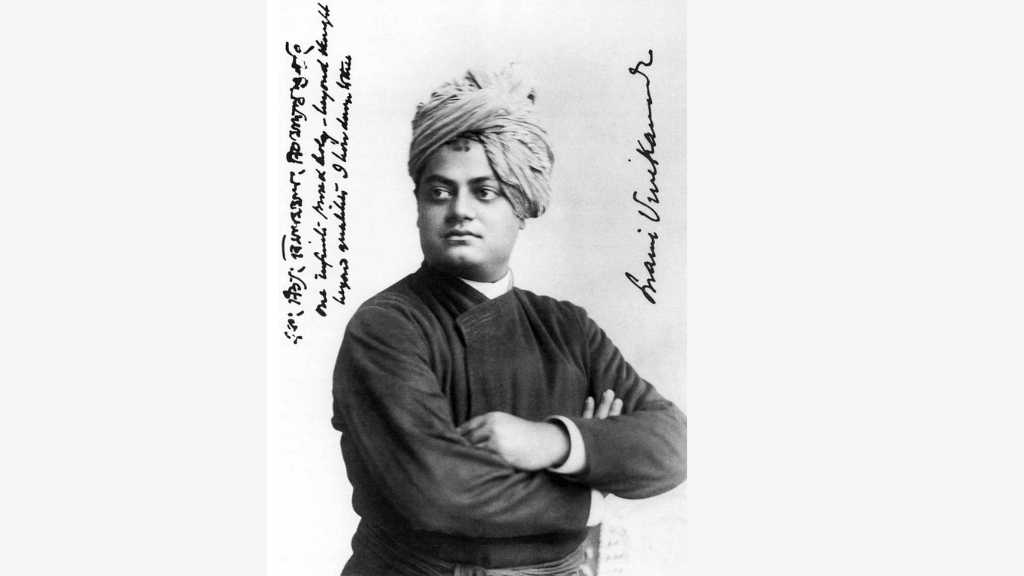
Many people deride this as idol worship. There is a well-known anecdote from the life of Swami Vivekananda. When he arrived in Alwar, Maharaja Mangal Singh—proud of his modern ways—mocked the monk’s “beggar’s life” and labeled idol-worship meaningless. In response, Vivekananda pointed to a portrait of the king’s father and asked someone to spit on it. Furious, Mangal Singh realized the painting was simply a symbol of his father, just as an idol is a symbol of God. Humbled, he apologized and understood the essence of idol worship. Source: “Real Meaning of Idol Worship,” VivekaVani, January 19, 2019. Image source: Wikipedia
In yogic meditation, a murti helps represent the “idea vision” of God per the tradition of that temple. It helps focus all your mental energies on a chosen ideal. In essence, “You become the object of your meditation.” In other words, you are not “worshipping” a stone idol. You are using the “murti” to help you focus your mind on that which the murti represents. Also, since the murti is “alive” with Prana (the same Prana that animates all life) it is not a mere piece of stone. In any case, in from the Sanatani perspective, everything is a modulation of the same consciousness. Everything has consciousness and everything is conscious. Other examples of symbols considered sacred or worthy of respect include the national flag of a country or an image of its founder or national father, all of which people hold in deep reverence as representations of something greater.
Sacred Geometry: Aligning Architecture with Cosmic Harmony
Vastu Shastra says, “Geometry exists everywhere in the cosmos, and it forms the root of all creation.” This resonates with the idea of sacred geometry, which bridges the gap between architecture and spirituality by aligning structures with cosmic harmony. Sacred geometry is therefore the foundational design principle that makes temples places where cosmic energy naturally converges.
Historical Context
The ritual geometry tradition indeed goes back to the Shulba Sūtras (part of the Vedic corpus). The Āgamas further codified temple building methods. The Shilpa Śāstras do view geometry as central to invoking cosmic order in sacred structures. Temple designs employ mandalas and yantras, often in complex repeating patterns that modern observers liken to fractals.
Key Concepts in Sacred Geometry
• Mandala and Vastu Purusha Mandala: These diagrams represent the universe. Vastu Purusha Mandala maps out the temple’s layout, aligning it with cosmic forces. The central point, Brahmasthana, is the holiest part, where the main deity (Murti) resides, embodying the temple’s spiritual core.
• Fractals and Self-Similarity: Think of an infinity mirror—repeated, self-similar patterns. This mirrors the idea that each part of the universe contains a replica of the whole—the cosmos is holonomic.
• Yantras: These mystical geometric diagrams harness and channel divine energy. The Sri Yantra is particularly important in our spiritual and tantric tradition. Temples like Meenakshi Temple in Madurai and the Khajuraho Temples incorporate yantras to amplify spiritual power.
Case Studies in Sacred Geometry
1. Kandariya Mahadev Temple, Khajuraho (Madhya Pradesh)
A textbook example of fractal geometry. Smaller replicas of the main shikhara reappear in scaled-down forms. This “nested” design reminds us of the universe’s endless interconnectedness. Image: Wikipedia.
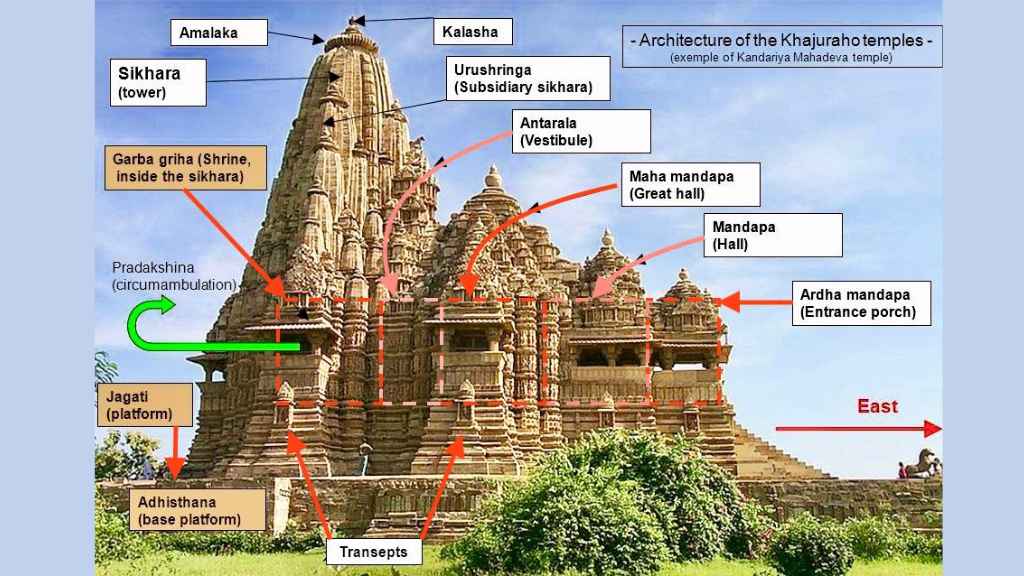
2. Brihadeeswarar Temple, Tanjore
A UNESCO World Heritage Site, the temple’s layout aligns with cardinal directions. The towering vimana represents a channel linking Earth to the divine cosmos, all based on precise mathematical and sacred geometric principles. Image source: Wikipedia.
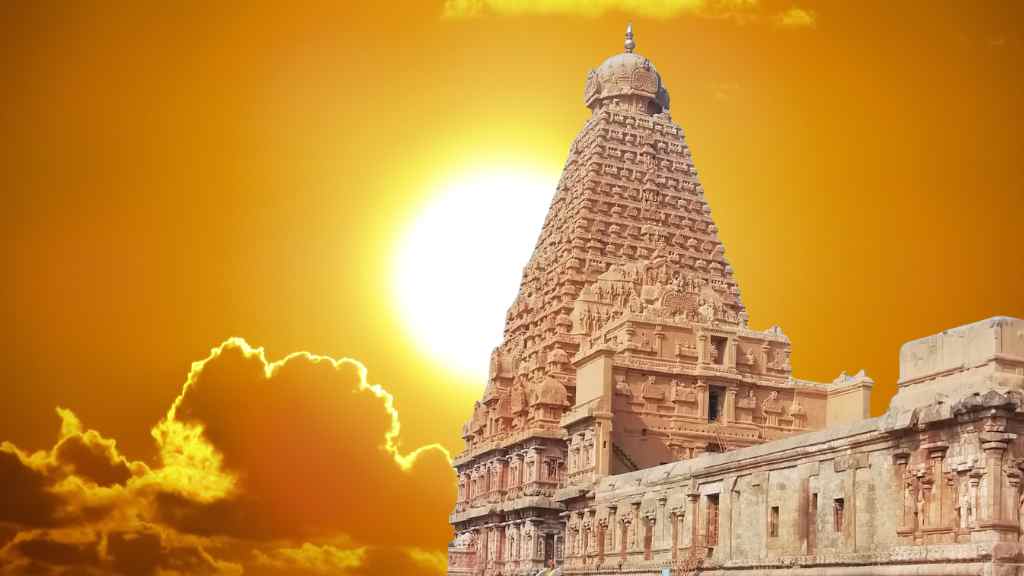
3. Sun Temple, Modhera (Gujarat)
Notable for its astronomical alignment. It employs a 64-grid mandala representing the 64 arts in Sanatana philosophy. The layered, concentric design reflects a worldview of cosmic expansion from a central point. Image source: Wikipedia.
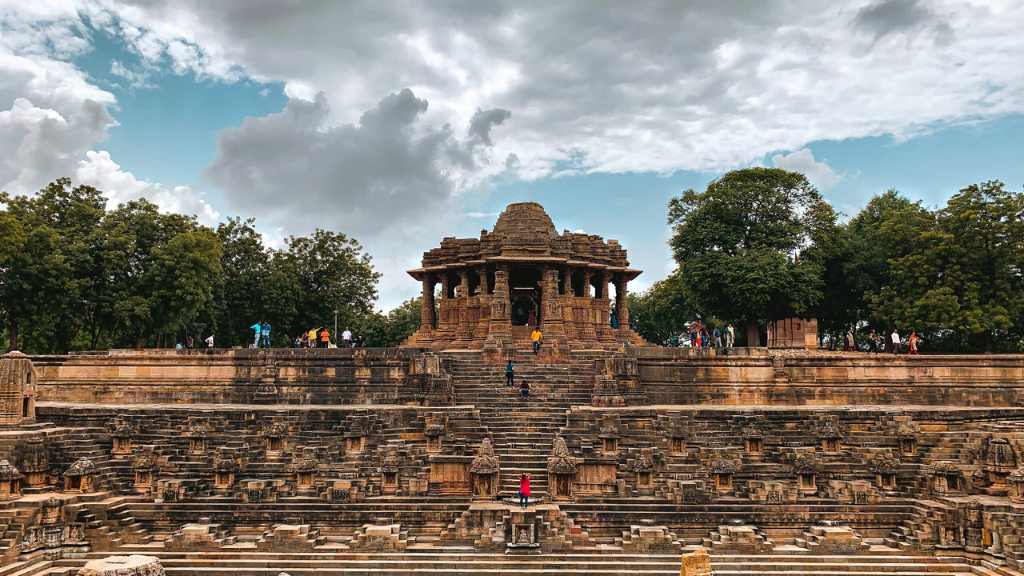
4. Meenakshi Temple, Madurai
Known for intricate gopurams (gateway towers) that use self-repeating, fractal-like patterns, signifying the devotee’s ascent from mundane reality to spiritual transcendence. Image source: Wikipedia.
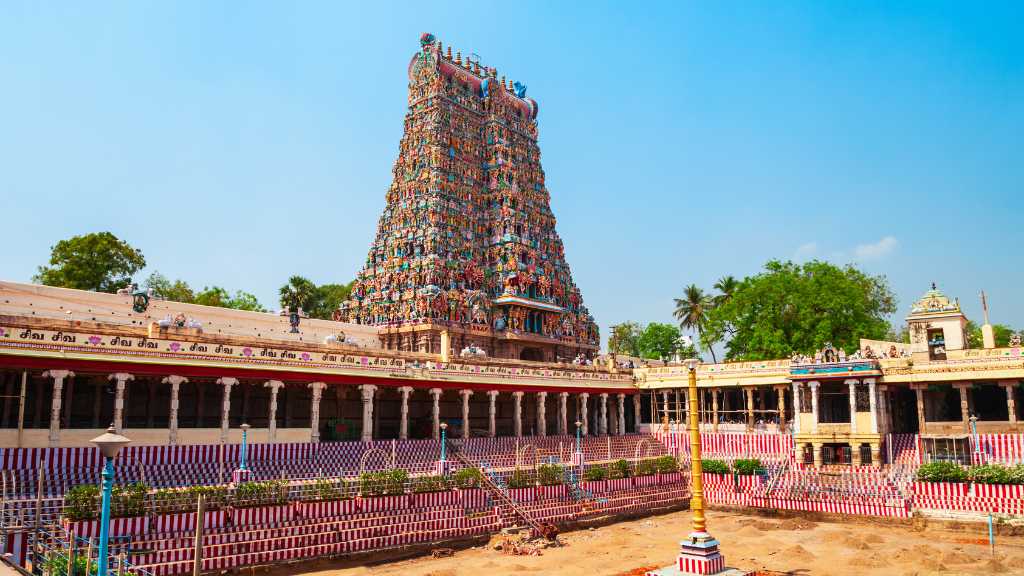
Deeper Dive: Hoysala Temples and Fractal Patterns
Chennakeshava Temple, Belur
• Dynasty & Date: Built by the Hoysala Empire in the 12th century under King Vishnuvardhana.
• Fractal-Like Elements: A complex, stellate (star-shaped) plan that repeats star points around the garbhagriha (sanctum). Intricate, nested carvings with multiple layers of ornamental bands. Repeated motifs—floral, mythological, and geometric—on progressively smaller scales. Image source: Wikipedia.
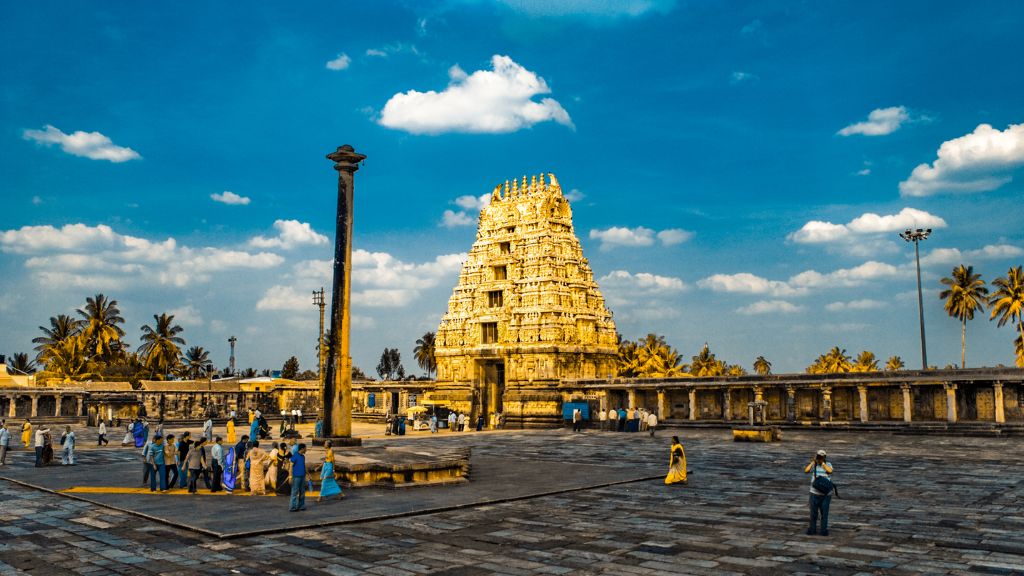
Hoysaleswara Temple, Halebidu
• Dynasty & Date: Also a 12th-century Hoysala creation, attributed to King Vishnuvardhana’s reign.
• Fractal-Like Elements: Double-shrine (dvikuta) plan featuring repeated star-shaped projections. Highly detailed carved friezes depicting rows of animals, mythological stories, and floral scrolls in tiers. Each tier mirrors and recasts similar forms, creating a visually recursive effect. Image source: Wikipedia.

Keshava Temple, Somanathapura
• Dynasty & Date: Built in the 13th century under the later Hoysala rulers.
• Fractal-Like Elements: Another stellate temple with a trikutachala (three-shrine) plan, each shrine carrying a star-shaped base. Ornamental motifs repeated in multiple layers on the vertical walls. Recurring patterns of miniature temple towers (shikharas) sculpted along the external walls. Image source: Wikipedia.
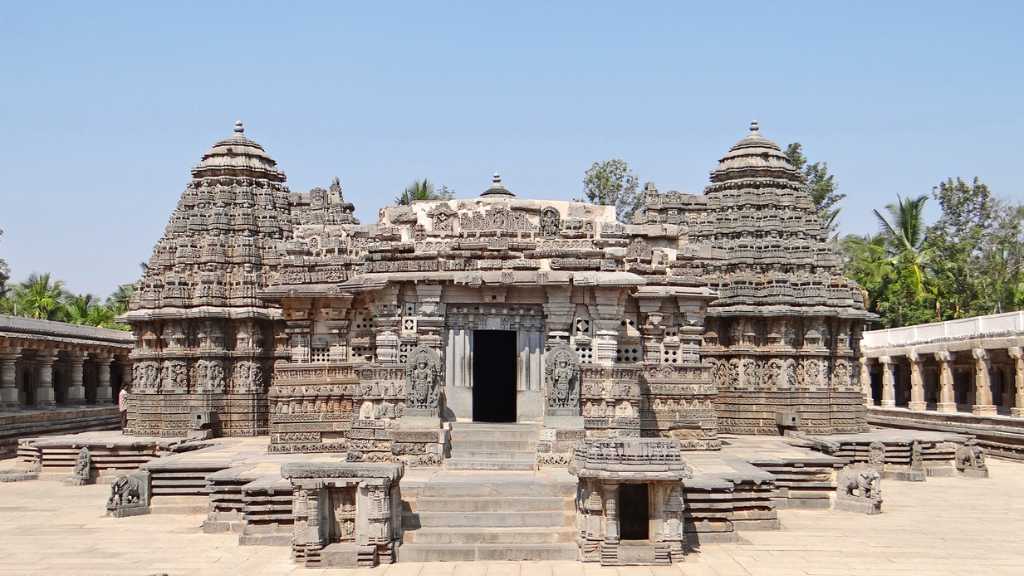
Lakshmi Narasimha Temple, Nuggehalli
• Dynasty & Date: Mid-13th century Hoysala architecture, built during the reign of King Vira Someshwara.
• Fractal-Like Elements: A star-shaped (stellate) ground plan. Sculptural reliefs on the outer walls showing repeated mythological scenes, each framed within ornate borders that interlock in a self-similar pattern. Image source: Wikipedia.
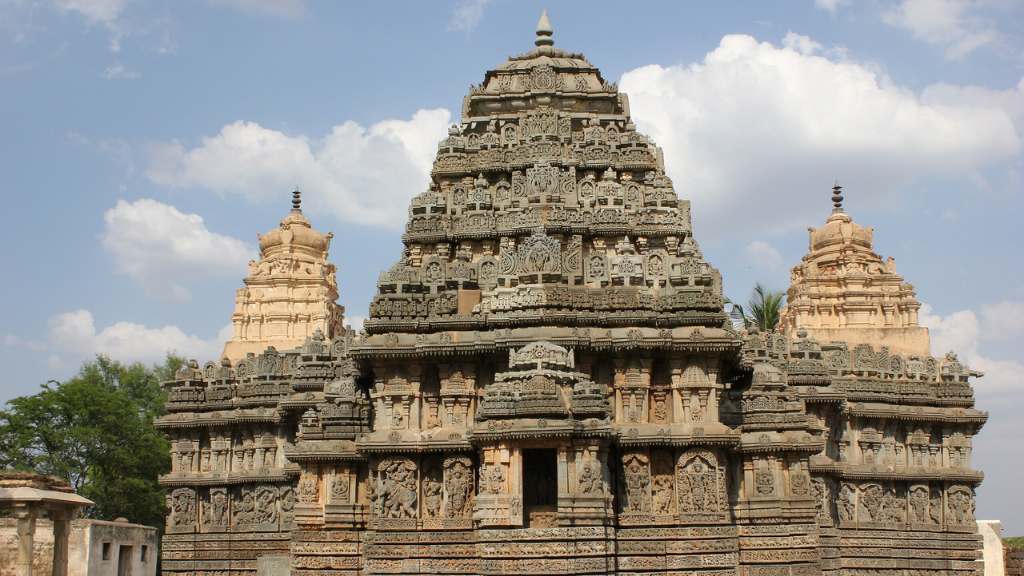
Modern Relevance
Sacred geometry’s influence endures in contemporary design, especially in sustainable urban planning. Architects adopt these millennia-old principles—golden ratio, symmetry, fractal patterns—to produce spaces that are aesthetically pleasing and energetically balanced. Aligning with “Yatha Pinde Tatha Brahmande” (As is the microcosm, so is the macrocosm), these design choices echo natural forms and cosmic proportions, instilling a sense of harmony in modern structures.
Beyond Architecture: The Multidimensional Purpose of Temples
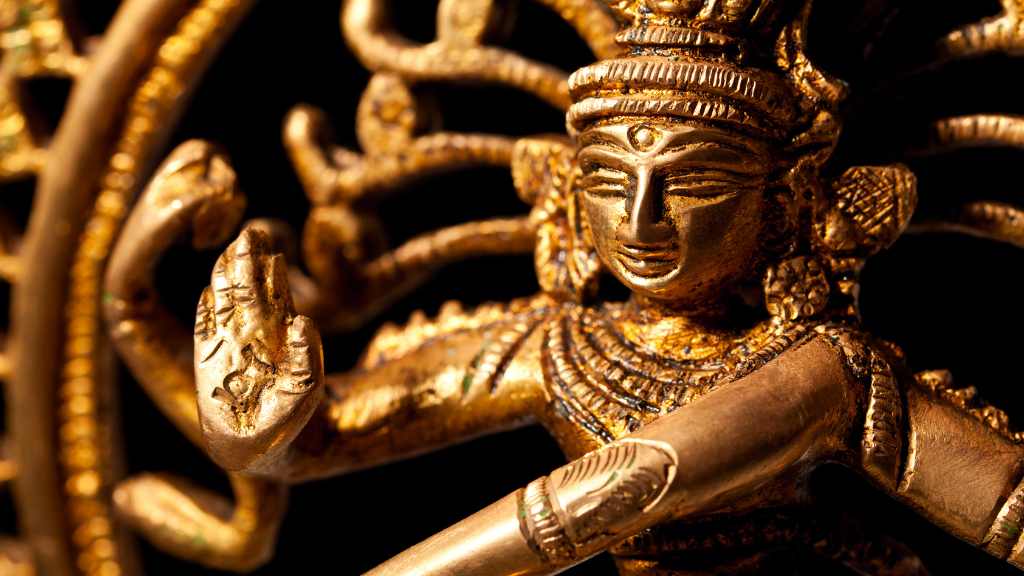
A temple is far more than a building; it’s a miniature cosmos encompassing Earth, Water, Fire, Air, and Space—the Pancha Bhootas—alongside the deity that presides within. Everything from the site selection to the idols, from the orientation to the rituals, is designed to induce inward focus and meditative states, aligning the visitor’s frequency with the temple’s.
Structure of the Temple
The universe is composed of the five elements—Prithvi (Earth), Jal (Water), Agni (Fire), Vayu (Air), and Akash (Space). Temples symbolically integrate these elements:
• Foundation as Earth
• Sanctum walls as Water
• Tower (vimana) as Fire
• Upper tiers as Air
• The unseen space above as Akash
Vertically, the sanctum (Garbhagriha) is the head or neck, while the lofty tower is the head, crowned by the Kalasha.
Why Temples Matter: Fourteen Key Dimensions
1. Libraries in stone: Preserving knowledge in carvings and inscriptions.
2. Places to bathe in cosmic energy: Built on geospots vibrating with Earth’s magnetic fields.
3. Therapy centers: They are therapy centers which are designed to set right the energetic balance of your body.
4. Wellness centers: They are wellness centers that help to ground and stabilize the mind and ready it for true yoga (as different from the asana focused yoga that is being marketed everywhere, especially in the west
5. Classrooms: They are places that teach and impart the key aspects of our philosophy, science, culture, cosmology and itihaasa to younger generations.
6. Introducing Rta to younger minds: They are also places that introduce younger generations to the natural and supernatural aspects of life and also the natural cycles of life and the deep esoteric meanings of what would generally be considered ordinary elements and activities of everyday life.
7. Community hubs: They can also be places where spiritually oriented people who know each other meet and also like-minded people with spiritual inclinations can meet and discuss matters of the beyond.
8. Divine arts: Just as in the past, they can once again be centres of divine art such as classical dance which was again used to raise consciousness of the audience through performance and also help people connect with the divine and enter samadhi.
9. Justice centers: Historically, disputes got settled under the divine gaze. They were often places were disputes were settled and as it was believed that people would be compelled to speak the truth in the premises of the temple and the divine forces would help reach a fair verdict.
10. Economic hubs: Supporting vendors and artisans. In fact temples were the center of life and economy in ancient times – even today a typical large temple support many vendors whose livelihood depends on the temples such as flower sellers, coconut sellers, garment stores, etc.
11. Hosts to key life events: Temples are also places where people celebrate birthdays, namakarana (naming ceremony), upanayana, weddings, shraddha etc 12. In many temples astrologers are available to help people decide the best time (muhurta) for auspicious events such as weddings and also for other rituals.
12. Astrological guidance: Many temples have astrologers on site to advise on auspicious timings.
13. Repositories of ancestral knowledge: Beyond all this temples are also great repositories of information of the way of life of our ancestors and are also a great attraction for students and scholars who are engaged in studying ancient Indian architecture.
14. Feeding communities: Annadana (free food) offered to visitors. A majority of temples provide free food and feed thousands of people daily (all depending on the size of the temple and who controls it – govt or a private trust).
15. Ambassadors of Ancient India to the world: Our temples can also serves as outstanding examples of what our civilisation has achieved in the past and can achieve in the future. In that sense, they can act as our ambassadors to the outside world.
Only by recognizing these facets do we reclaim the temple’s place as an integral part of our daily lives.
Journeying Through India’s Temples
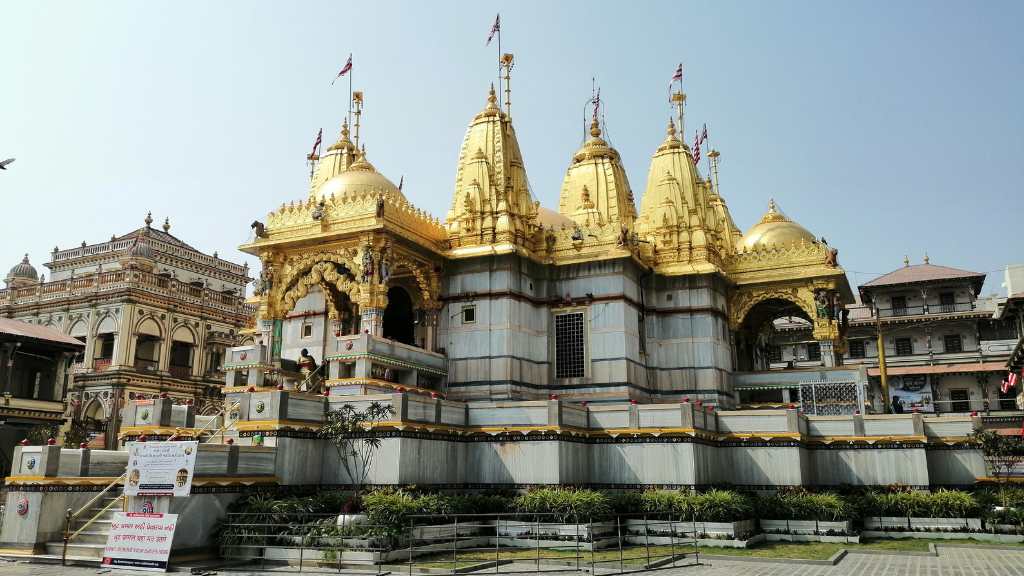
Visit as many temples across India as possible: Dharmasthala, Hampi, Kadri near Mangaluru, Udupi, Dharwad, Gadag, Mysuru, Bengaluru, Hasana, Gokarna, Palani, Madurai, Rameshwaram, Thanjavur, Sri Rangam, Thiruvannamalai, Horanadu, Guruvayoor, Thrissur, Kolluru, Varanasi (Kashi), Prayag, Gaya, Ellora, Ajanta, Mahabalipuram, Kalahasti, Tirupati, Pune, Pandharpura, Odisha, West Bengal, etc.—across the length and breadth of India. Try to cover at least 20–30 temples in one trip. That is when you will start noticing patterns. From North to South, from East to West, these temples share certain commonalities and reveal intriguing differences in design. Yet, there is always a definite, underlying blueprint.
For instance, walk through the streets of Kashi (Varanasi) and allocate at least 7 days for this walking tour. Don’t skip even a single temple, big or small. Meditate on the Dashashwamedh Ghat or the Assi Ghat. Kashi is itself a living Yantra. Every stone, every alley, and every shrine is intentionally placed. You will find yourself asking: How did they manage to build a city that functions as a Yantra in itself?
Design by Intention
“Design is a discipline of study and practice focused on the interaction between a person—a ‘user’—and the man-made environment, taking into account aesthetic, functional, contextual, cultural and societal considerations.”
As you travel around India, you will notice there is a certain design to everything—temples, buildings, houses, streets, shops, wells, and so on—all crafted with a deeper purpose. You cannot design something without a purpose.
The Sanatana temples are especially intricate. There is the complexity and intricacy of the temple architectural design and then there is the question of the technology, the human skills, manpower, and the sheer artistry of the sculptors who accomplished these feats of human engineering.
Try to visit the temples of Beluru and Halebidu in Hassan, Karnataka, and spend a good 4–5 days to “see” each and every inch of these temples. There is a certain thought, purpose, and intention behind every feature and every single sculpture—like a beautifully directed movie where not a single scene is wasted. These temples are cinema halls where the movies of our ancient glorious past have been playing nonstop for centuries, come rain or shine. The sculptors were the storytellers, and the kings and merchants who patronized and funded these temples were the producers.
Visit these temples multiple times over several days, each time wearing a different hat: first as a tourist, then as a researcher, then as a devotee, and finally as a sadhaka. You will notice different facets. Talk to the priests, the people who live around the temple, learn about the history, and note how your experience changes with your perspective. Now, do the same at 10–20 other temples in other parts of the country. Compile all your notes and pictures, and a story will come to life.
You will realize that a lot of time, money, and effort went into building each one of these temples. Why? Why did they put so much effort into building these temples? Why were they so important? And now think of the 40,000+ temples that were destroyed/occupied/modified by invaders. What secrets did they contain? What stories did they hide in their bosoms?
The Heart of Community Life
These temples were the center of life and activity in their respective cities. Can you compare them to other places of worship? Why or why not? After the why question, we have to tackle the how question: How did they do it? How did they pull off the seemingly impossible feats of building such massive, intricate, and meticulously crafted temples? And who were these people who built these marvels?
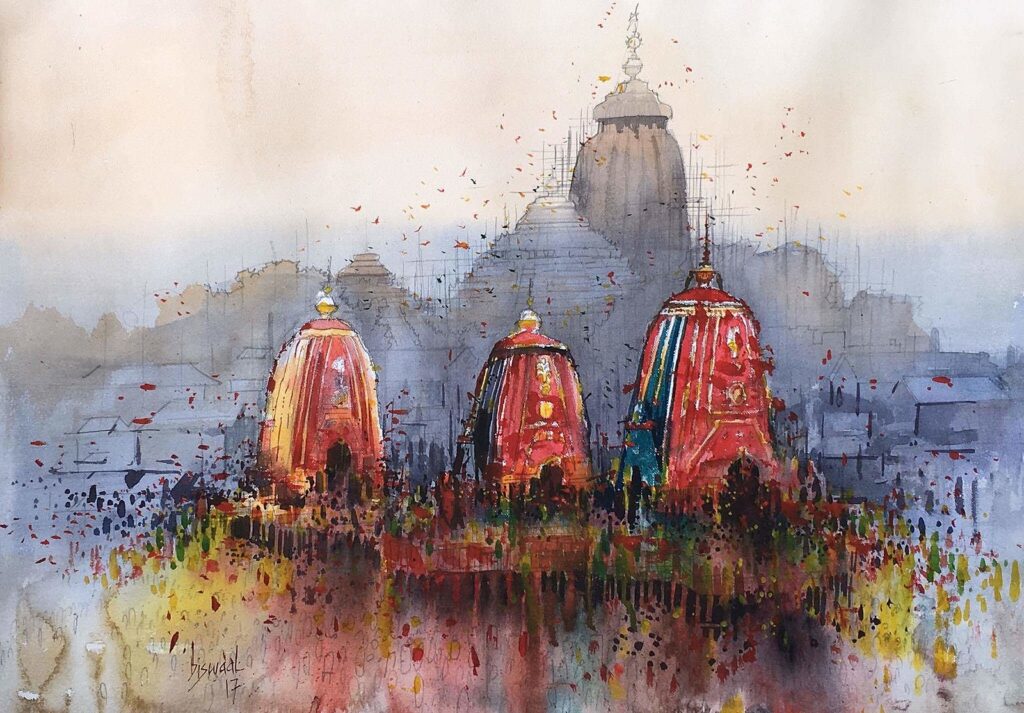
Image courtesy: https://commons.wikimedia.org/wiki/File:Rath_yatra.jpg
At this point, you realize temples were libraries in stone, cinema in stone, divinity in stone—centers of art, music, sadhana, worship, occult, festivals, justice, and commerce. To carve entire knowledge libraries and features that produce divine experiences (even today), what might the sculptor have studied? Where did they study, under whom, and how was this knowledge passed on through generations despite wars, famine, foreign occupation, and colonial rule? How were the stones chosen and moved to the temple sites?
Surely, these were no ordinary sculptors, no ordinary workers, certainly no ordinary kings. And what can we infer from our understanding of the design of these temples and the study of the materials used and the technologies applied?
Most importantly, what can we infer from the experiences we have even today in temples built 1,000–2,000 years ago? We are able to build rockets that take us to the moon and other planets, but we cannot build another temple like Kailashnath, Brihadeeshwara, or the Chennakeshava temples. Why is that?
Conclusion: A Pathway to Higher Consciousness
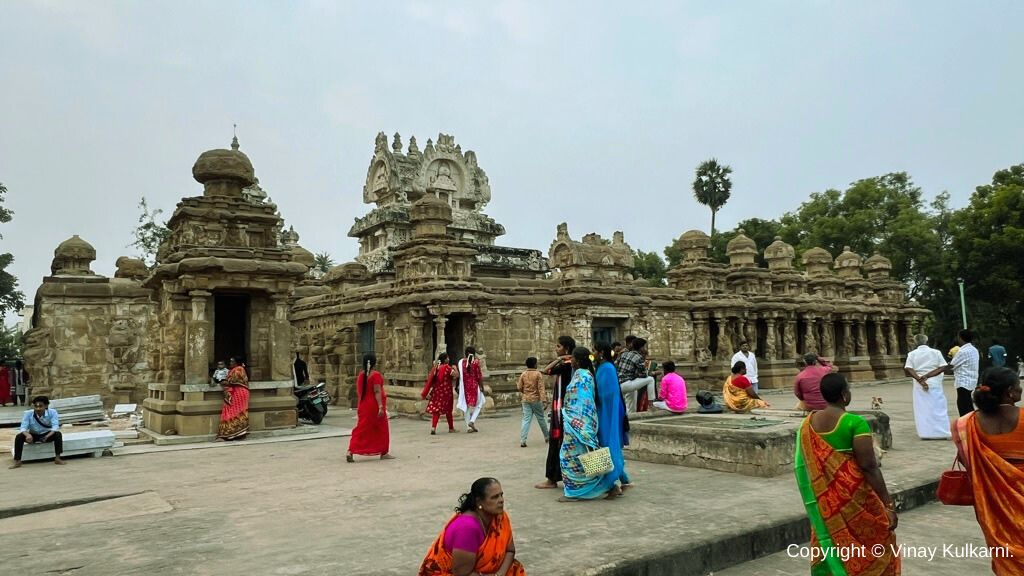
The minute you stop thinking of temples as merely religious structures, a whole world of possibilities opens up—for businesses committed to employee wellness, for schools eager to impart cultural and spiritual education, and for families seeking to enrich their lifestyle with subtle energy experiences.
Indeed, the Siva Sutras declare:
“Chittam Mantraha.” (1) चित्तं मन्त्रः।। (Chittam Mantra)
(a) With intense practice, the mind becomes the mantra, reflecting the Real.
(b) Individual consciousness conforming to a mantra attains the goal seeded within that mantra.
(c) Mantra is a method to give individual consciousness an exposure to the supreme consciousness.
And the temple is the best place to experience this convergence of mind, mantra, and higher reality. By exploring sacred geometry, fractal designs, Vastu Purusha Mandalas, and the multidimensional roles temples have played for centuries, we find a path that unites ancient wisdom and modern innovation—a path that enriches us intellectually, emotionally, and spiritually.
Ultimately, temples are gateways for realizing the profound harmony that underlies all creation, connecting us to the cosmos and illuminating the possibilities of a life lived in alignment with the divine. So, what can you infer from the design of our ancient temples and monuments? Perhaps it is time we rediscover this design knowledge and re-apply it—not merely to build structures, but to construct experiences that elevate and transform humanity as a whole.
The post Ancient Centres of Learning first appeared on Vinay Kulkarni.
]]>The post You only see what you are ready to see! first appeared on Vinay Kulkarni.
]]>
Human perception is not a simple act of registering reality; rather, it is deeply intertwined with the mind’s capacity to interpret and integrate information. Psychologists often note that people don’t truly “see” something until they are psychologically and emotionally prepared to perceive it. This concept has profound implications across personal growth, spirituality, education, storytelling, and even science. Let us explore this idea through various lenses, weaving together insights from psychology, mythology, spirituality, history, literature, and the transformative ideas of myth and metaphor.
Psychological Readiness: The Gateway to Perception
In psychology, the phenomenon of perceptual readiness highlights how our minds filter the overwhelming flood of sensory data based on what we are prepared to notice. This explains why, at certain points in life, we can suddenly understand or appreciate something that previously eluded us. Whether it is grasping a complex concept, recognizing a life lesson, or seeing an opportunity, perception is guided by psychological readiness. I have had this happen to me repeatedly throughout my life. However, with sadhana one does see that insights come in a kind of a flow, and it is very gratifying when everything finally begins to make sense!
The mind acts as both a lens and a filter, allowing us to focus on information aligned with our current stage of mental and emotional evolution. This idea is vividly captured in the works of mythologist Joseph Campbell, who stated, “The hero gets the Adventure he is ready for.” Just as a hero in a myth must grow to face challenges, we, too, only “see” what we are prepared to tackle. In other words, your life until now was a preparation for what you are about to see and what you are about to do because of what you see!
The Transformative Power of Myth and Metaphor
Joseph Campbell’s work on myth and metaphor expands this understanding of readiness. He asserted, “Every myth is psychologically symbolic. Its narratives and images are to be read, therefore, not literally, but as metaphors.” Campbell’s approach reframes myth not as a relic of imagination but as a profound vessel of universal truth.
While rational minds often dismiss myths as falsehoods, Campbell argued that myths convey truths far deeper than those bound by logic. He famously stated, “Myth is much more important and truer than history. History is just journalism, and you know how reliable that is.” Myths address timeless human qualities such as beauty, honor, love, family, and community. Their layered meanings and universal themes speak directly to the emotional, psychological, and spiritual dimensions of life. For instance, in India, we really do not spend too much time trying to investigate or prove that Rama or Krishna existed. What is more important for us is the lessons we can learn from their lives. Again, in many ways Rama is a metaphor for Dharma – “Ramo Vigrahavan Dharmaha.”
Metaphors are more than a linguistic device – metaphor serves as a lens that magnifies meaning. Campbell observed, “Half the people in the world think that the metaphors of their religious traditions, for example, are facts. And the other half contends that they are not facts at all. As a result, we have people who consider themselves believers because they accept metaphors as facts, and we have others who classify themselves as atheists because they think religious metaphors are lies.”
By redefining myths and metaphors, Campbell transformed them into dynamic tools for understanding the world and our place within it. For storytellers, this perspective offers an opportunity to create narratives where every element—dialogue, action, relationships, and events—is charged with layers of emotional, psychological, and spiritual meaning. But storytelling does not have to be relegated to books and movies. We can integrate storytelling into pedagogy, simple daily conversations, parenting and also to train and inspire our employees.
Metaphors are meaning capsules
Metaphors are like capsules into which truth and meaning can be packed into a shape and form which allows it to transfer that meaning and insight to people transcending cultural and linguistic barriers. Of course, many metaphors are completely rooted in the culture and language of the society from which they originated. However, even metaphors have been translated and adapted from one culture to another. The meaning can completely change however.
Spiritual Insight: Questions as Mirrors
Indian spiritual gurus often use a seeker’s questions as a barometer of their spiritual evolution. The questions we ask are reflective of our current understanding, experiences, and aspirations. A wise guru provides answers tailored to the seeker’s readiness, nudging them gently toward their next step on the spiritual path.
This personalized approach recognizes that insights cannot be imposed prematurely. As the Zen saying goes, “When the student is ready, the teacher appears.” The teacher’s role, much like that of a guide on a journey, is to illuminate the next milestone, not the final destination – to show the way but allow the student to walk on it himself. There is another Zen saying, “Buddha’s enlightenment solved his problem, now you go and solve your problem!”
And as Sri Aurobindo says, nothing can be taught. I remember reading somewhere, “If you try to teach a man, he will not learn” – attributed to Bertrand Russell. To that someone has this offered this solution (I cannot remember who said this right at this moment): “A man must be taught, as if naught; and a thing new proposed as if a thing forgot!”
Metaphors can be pedagogical tools
Metaphors can help you explain a complex concept by helping students encounter the unknown through what is already known to them. Coming up with instant metaphors is at once a creative art and a science as well. I believe anyone can learn to come up with meaningful metaphors. I plan to run an experiment to test out my belief.
Historical Anomalies: The Invisibility of the Unimaginable
This is something I read long ago as an introduction to a book on mathematics. When Spanish ships landed on the shores of Pacific islands, the indigenous people, having no concept of objects floating on water, could not “see” the ships. Their minds could not process the unprecedented sight. The islanders’ medicine man, however, was able to notice the subtle disturbance in the water and, through focused observation, eventually recognized the ships. This illustrates how readiness and context shape perception: we see only what our mental framework allows us to see.
Climbing the Mountain: A Gradual Revelation
The journey of understanding can be likened to climbing a mountain. At the base, our view is limited to what surrounds us. As we ascend, new vistas unfold, and our perspective broadens. By the time we reach the summit, we can see the entire mountain and its surroundings—a metaphor for achieving clarity and wisdom after a journey of growth. That is why when a man at the summit tries to describe what he is seeing from his vantage point, the people down people often are not able to relate to what he is saying. The funny thing is when we finally understand what someone is “saying” (which is audio), we often exclaim, “I see what you are saying!” (which is visual). This is because we convert information into insight using a visualization process. If we don’t understand what someone is saying, we might say, “I am drawing a blank!”
The poet T.S. Eliot captures this beautifully in his lines:
“We shall never cease from exploration,
And the end of all our exploring
Will be to arrive where we started
And know the place for the first time.”
This cyclical journey of discovery emphasizes that understanding deepens through experience, reflection, and iteration.
Education: Repetition with Depth
In school, many of us encounter the same topics year after year—fractions, photosynthesis, the scientific method—but with increasing depth and complexity. This is no accident; it mirrors how human understanding evolves. Each new layer builds on the last, enabling us to revisit earlier concepts with fresh eyes and greater insight. This iterative learning process reflects our growing capacity to perceive and integrate knowledge.
The Scientific Method: Seeing Through Iteration
The scientific method provides a structured way to expand our understanding. It begins with a hypothesis, a preliminary guess based on limited knowledge. Through observation, experimentation, and analysis, we refine our understanding step by step. Each iteration brings us closer to the truth, much like turning the pages of a novel brings us closer to its resolution.
The iterative nature of science reflects how human perception evolves: we start with a fragment of understanding and gradually build a comprehensive picture.
A Flexible Mindset: Letting Go of “Foolish Consistency”
Growth requires the courage to let go of rigid beliefs and embrace new perspectives. Ralph Waldo Emerson captures this idea in his famous observation:
“A foolish consistency is the hobgoblin of little minds.”
Consistency for its own sake can trap us in outdated paradigms, blinding us to new insights and opportunities. True growth demands flexibility—a willingness to adapt as our perception deepens and expands. This mental agility is what allows us to move beyond old patterns and see the world anew.
Ultimately all learning involves a certain amount of pain that comes from having to give up rigidly held beliefs!
Synthesis: A Path of Perpetual Growth
Whether in psychology, mythology, spirituality, history, literature, or science, the recurring theme is clear: we perceive, learn, and grow incrementally, aligned with our readiness. Insights, truths, and revelations are not static; they evolve with us, appearing when we are prepared to receive them.
This understanding offers a profound lesson: rather than rushing toward conclusions or forcing insights, we should focus on preparing ourselves for growth. By cultivating awareness, curiosity, and openness, we align ourselves with the natural rhythm of discovery. As we climb the mountains of our lives, turn the pages of our unique stories, and explore the unknown, we move closer to seeing the unseen and understanding the yet-to-be-understood. Life’s journey, much like a myth, unfolds in layers—each offering a richer and deeper view of the truths that define our existence.
However, if you are patient and observant, you will realize that it was always about the journey – a journey of learning and discovery. And that is the destination!
ॐ असतो मा सद्गमय ।
तमसो मा ज्योतिर्गमय ।
मृत्योर्मा अमृतं गमय ।
ॐ शान्तिः शान्तिः शान्तिः ॥
Om Asato Maa Sad-Gamaya |
Tamaso Maa Jyotir-Gamaya |
Mrtyor-Maa Amrtam Gamaya |
Om Shaantih Shaantih Shaantih ||
Meaning:
1. Om, guide me from illusion to the truth of my eternal self.
2. Lead me from ignorance to the light of spiritual wisdom.
3. Take me from the transient world to the eternal realm of self-realization.
4. Om may there be peace, peace, and peace everywhere.
5. May all experience auspiciousness.
6. Om, peace, peace, and peace.
The post You only see what you are ready to see! first appeared on Vinay Kulkarni.
]]>The post SRIVIDYA DEMYSTIFIED first appeared on Vinay Kulkarni.
]]>The choice of the vehicle for the trip depends on the following factors:
The destination – whether you are headed to Las Vegas or Yellow Stone National Park
The distance you need to travel – whether its 100 miles or a 1000 miles
The number of travelers – whether you will be driving solo or taking family or friends
And finally, how soon you wish to get there
So, based on the above factors you will choose a vehicle. Three important specifications will need to be considered:
The Body of the Vehicle
The Engine
The Fuel Capacity
This will translate into a hatchback, a sedan, a 4×4, a SUV or a cross-over. Anyway, you will choose a vehicle that can get you where you need to go while meeting all your requirements. Lets assume that budget is not a constraint.
Now, take your own life and life goals. If you think of your life as a long road trip and your ultimate life goal as a destination, then you would need the right kind of vehicle for this journey as well.
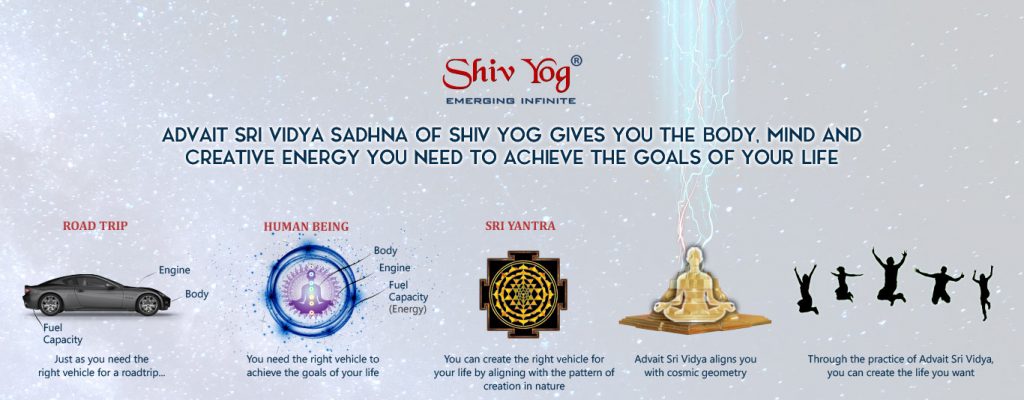
And the considerations would be the similar:
The Body – Your Physical Body, its health and stamina
The Engine – Your mind / Your state of consciousness
The fuel capacity – The sum total of physical, mental and emotional energy (shakti) needed
While in the case of a road trip, you can easily go to a rental car company and get the car of your choice, in the case of your life journey its not so easy. Many people find that there is a gross mismatch between the magnitude of their goals and the vehicle they have to achieve those goals. As a result they feel limited, finite and unable to evolve the vehicle to meet the requirements of their goals.
The ancient Shiv Yog masters of India it turns out, studied this problem in great depth and developed a very elaborate system of practices to help one achieve their goals (as long as the goals are in the best interest of the world/society).
They discovered the geometric pattern of creation of nature. The cosmic geometry. And they also discovered that in order to become a creator in this universe, a human being has to align himself with this cosmic geometry.
They found that the geometric pattern of creation in the universe translated into a figure known as a “Sri Yantra” which is created by the intersection of four upward facing triangles and five downward facing triangles. If one were to map out the creation pattern of an average human being who is struggling to fulfill his life goals, they would find a geometric pattern that is scattered. However, if the same person can transform his creation pattern to match that of a Sri Yantra he would be able to achieve his goals easily.
Let us understand this further.
In order to help human beings achieve this alignment with cosmic geometry the ancient Shiv Yogi masters came up with a system which has three components:
A Yantra – which is not only a representation of that cosmic geometry but also something through which one can access that cosmic energy
A Mantra – Which is the key to unlock the associated Yantra
Tantra – Which is the process or method to align oneself to the cosmic geometry using the yantra and the mantra
This system developed and perfected by the Shiv Yogi masters is called Advait Sri Vidya. The word “Sri” literally means wealth. However, here it does not refer to material wealth alone. Its meaning covers wealth of all kinds – worldly and spiritual. The “Vidya” refers to knowledge or an entire body of knowledge. And “Advait” is non-duality. Put together, Advait Sri Vidya is actually a path, a yogic science for achieving all your material and spiritual goals. This is the Yoga of Inner Consciousness.
Whether you are a student, a housewife, a CEO or the president of a country, everyone is trying to achieve goals and also in achieving them they are trying to find happiness. Often, individuals are not able to achieve their goals and also achievement of those goals does not necessarily lead to happiness.
But, why do some individuals find it so hard to achieve their goals and find happiness and satisfaction? What are the roadblocks? Shiv Yog says, this is because the vehicle you have is not adequate to meet the requirements of your goals. The root cause for this is the accumulated negative psychic impressions* that are stored in your subtle bodies**.
So, what is the solution? Shiv Yog says do not throw up your hands and cry that you do not have the vehicle you need to achieve your goals. Instead become a creator of your own destiny. And through Sri Vidya it is possible to transform the vehicle you have into the vehicle you need to achieve your goals.
To be more specific,
Transform the Body Your Physical Body, its health and stamina.
Sookshma Kriyas***, Prana Kriyas***
Transform the Engine Your mind / Your state of consciousness.
Expand the Fuel Capacity The sum total of physical, mental and emotional energy (shakti) needed.
The Yoga of Inner Consciousness
There are many schools of knowledge and many paths taught by many masters in this world which want to help human beings in their life journey. So, one might ask what is so special about Advait Sri Vidya and why should I learn it.
First let’s clear some things about Advait Sri Vidya. When you become a Advait Sri Vidya practitioner:
- You do not have to give up desires – in fact you work on rapidly fulfilling your desires
- You do not have to renounce the world – in fact you will experience the best of the best that the world has to offer
- You do not have to renounce your family – in fact, your family is your best friend on this journey and all the great Shiv Yogi masters were householders
- You do not have to give up your business or your career – in fact everything gets better on the career front
- You do not have to go and live in a mountain retreat – in fact the very place where you live and work begins to feel like a retreat
- Advait Sri Vidya can help you build the right vehicle to help you achieve your desires and life goals – both material and spiritual –
Advait Sri Vidya helps you achieve worldly as well as spiritual goals while living happily with family
- As you achieve your worldly goals, you also simultaneously achieve spiritual growth
- You achieve a complete 360 degree transformation of your life
- You are able to rapidly dissolve the accumulated negative psychic impressions and open yourself up to receiving more of the cosmic energy
- you get more and more aligned with the cosmic geometry, you are able to create the life you always dreamed about
- You get more clarity about your life goals and your true purpose in life
- You become happier and more blissful in general – your happiness is now not dependent on external achievements although the achievements are coming more easily now
Dr. Shivanand says, to be consistently successful and to achieve your worldly goals without getting lost in the mire of desires, one has to vibrate at a higher frequency than the goal you are chasing. And that is what Advait Sri Vidya helps you to do. Advait Sri Vidya purifies an individual from the inside and raises his or her vibrations to such a high level that material and spiritual wealth flows in easily and effortlessly. However, the practitioner remains calm and humble in spite of all the success and progresses rapidly towards self-realization under the divine guidance of his master.
The post SRIVIDYA DEMYSTIFIED first appeared on Vinay Kulkarni.
]]>